#brecilian ruins
Explore tagged Tumblr posts
Text
Brecilian Ruins - DAO
[Remade post, originally from here]
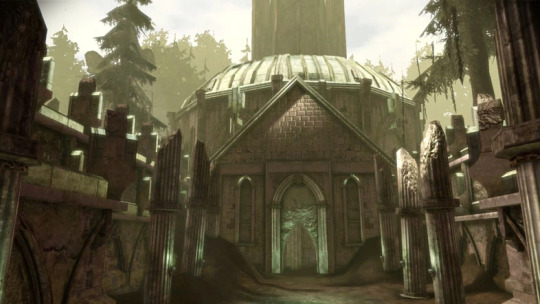
I don't know what to make of Brecilian Ruins. Can we truly trust DAO design with its statues? Spoiler answer: no.
[This is part of the series “Playing DA like an archaeologist”]
The following post contains
Tevinter architecture filled with Elven traps
Iconography
The Well of Sorrows: DAO version
The Tevinter Artefacts
Extra minor details
[Index page of Dragon Age Lore]
Tevinter architecture filled with Elven traps
The first thing we have when entering these Ruins is Morrigan telling us that, despite seeing the whole place with the same architecture we saw in the Ruins of Dalish origin, this is Tevinter. Sure, we can assume that the Dalish hunters know nothing of Elvhenan Architecture or Tevinter Architecture, so their opinion about those ruins being elven could be wrong from the first moment. They are, after all, extremely unreliable beholders of the reality.

Anyways, let's assume Morrigan is right and we see Tevinter arquitecture with Elven traps. This is quite different of what we usually find in Thedas: which is elven structures appropriated by Tevinter humans. This makes sense when you think that the elves were the first creatures in this world, and humans came later, in addition to Tevinter always co-opting any knowledge or techniques from the Elvhenan.
However in Brecilian forest the order of the events seems to be on the other way around. Historically speaking, it can be explained in the following way: we know that Tevinter invaded Ferelden and built many structures with defensive purposes, like Ostagar [which was built to contain the “danger” of the Chasind in the far South].
We also know in the DLC: Witch Hunt, that slaved elves ran away from the North to the South years later after the fall of Arlathan. We know they hid for a while in a Thaig, but maybe some could have reached these forest and inhabit the ancient human structures, protecting themselves with elven traps to keep Tevinter slavers away from them.
Another possibility is that Tevinter simply co-opted the Elven traps and used them in their own buildings. It would not be the first time doing this.
Iconography
The Ruin corridors and chambers are filled with statues. They are the same statues we saw in Zathrian's camp: Sylaise (woman with a vessel), Andruil (woman with a sword. Why? Should not be a bow?), and Ghilan'nain (woman without head and hands).

These are the same exact statues we find in any Chantry, Circle of Magi, or human town, so this is exactly why I never trusted DAO design in general. I don't know if the engine and its lack of resources made them reuse a lot of background details, or there is a real intention in them [I incline to the former]. Considering that DAO had almost 10 years of development, I want to believe that this is not by chance... but maybe the limitations of the engine forced them to remove most of the potential that environmental telling has to offer... I don't know.

In any case, inside the Brecilian Ruins we see a symbol or figure we also saw in the Dalish origin: a kind of dragon-head like figure, accompanied many times by one of those figures that we believe, it represents Andruil (the goddess of Hunt). This could also represent Andraste [who always has a sword or a shield in her representations] beside two figures that look like dragon heads. This would link Andraste with Dragons too, which has been a repeated association that we are not stranger to.
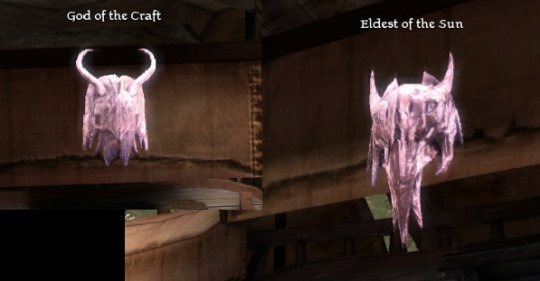
In DAO we see that the dalish are deeply related to Dragons too if we pay attention to the enviromental details that are not repeated anytwhere else: in Zathrian's clan we see many aravels with masks that are dragon-like skulls, and when you click on them, you find out it's a representation of one of their elven pantheon.

We see the concept art of these in the credits of the game.
By now it's quite difficult to say if this is an obvious link of the Elven Pantheon with dragons or maybe Old Gods, or it's just a vestige of former slave elves whose masters may have forced them to worship the Old Gods. It is not strange that a slaved group takes the religious symbols of their slavers and worship them in the name of their own (forbidden) gods. We know that we can't trust in Dalish tales as reliable sources of History, because it's extremely fragmented and lost (thanks to DAI we are truly aware of how false they are containing barely a pinch of truth in them, twisted and romanticed).
On the other hand, I am inclined to think that this is just a representation of how the Elvhenan had, originally, a religion based on Dragons. We know that they venerated a “divine” shape that was meant for their gods and their chosen ones that implied Wings, and due to Mythal’s shape, we associate this Divine Shape with the form of a Dragon. Additional material that can support this speculation can be found in the first three comics of DA comics [The Silent Grove , Those Who Speak, Until We Sleep] where we are informed that the Dragons were the ones who controlled the skies originally, possibly had a broad power over the Fade [Dreamer-like, so from the Fade they could alter reality], and they may have been related to an original non-fragmented “song” that everythign and everyone in the world sang. Also, Dragon Blood is “the blood of the World”, placing the Titans in a confusing position within the lore.

In these Ruins we find a codex of Falon'Din. Which is the same god that Talem told us about when we asked him if he could identify that strange winged statue. So... the confusions gets worse here: it's a Tevinter Ruin, with elven traps, and Elven God statues.
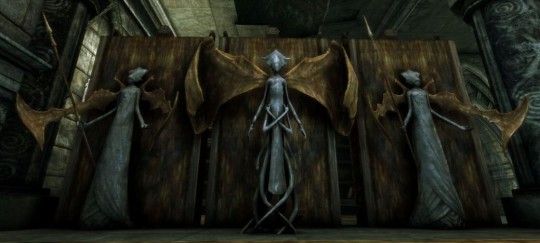
It’s impossible to overlook the fact that this statue of Falon’Din has strong resemblance to the Old God statue of Urthemiel. As if Falon’Din wanted to have the shape of Urthemiel.
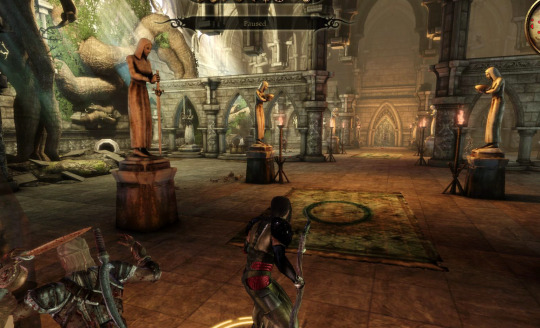
The chamber with the fire traps displays “Sylaise” and “Andruil” statues. Which in terms of Dalish Elven lore makes little sense. Andruil? Sure, she is the hunter goddess, though in these statues she is not in a aggressive stance. So is she chasing after you?. And what about Sylaise? The goddess of the domestic arts? Trying to kill you? Protecting the home of the elves? In a Tevinter structure? This makes a bit of more sense if we keep in mind what we know about Andruil from DAI and the little bit of Sylaise [read their sections in Evanuris]; Sylaise is a very agressive, envious goddes of Fire, who is described top have fire breath [like a dragon?], as powerful as Andruil’s spear [a very dangerous and brutal weapon so far we know]. Andruil is presented to us in DAI as the goddess of Sacrifice, brutal and merciless so far we can gather from the codices. So both goddesses seem to fit a bit better in a deadly trap room if we keep in mind the interpretation we had from DAI.
The Well of Sorrows: DAO version
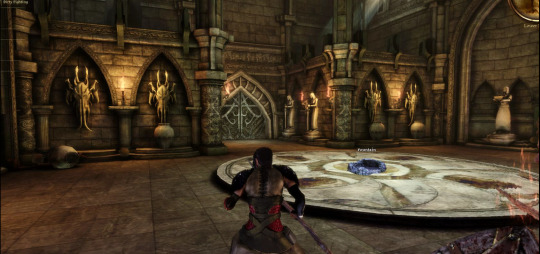
Then we reach to our first "Well of Sorrows". Or more like "Puddle of Sorrows", lol. Once again, we find a wall covered with that Dragon-like skull statues of “Andruil” and “Sylaise” [I keep the quotation mark because we know we can’t trust little these representations]. We also find the codex of an ancient elven tablet explaining the ritual which, after DAI, makes more sense. You drink from the water of the pool, taking the knowledge left by other elves, and then you put the rest of the water in it, leaving your knowledge there [it works similar to what Abelas explained about the Well of Sorrows]. It seems to be corrupted or empty since you don’t have any whispers or sudden knowledge inside your head, and many Shades are summoned if you fail in the procedure. This chamber unlocks the following one where we find the Uthenera chamber.

Since the only Elven god codex we found in these ruins is Falon'Din’s, it could be fair to believe that this may be interpreted like a "Well of Falon'din" which gathers all the knowledge of those elves that want to stop living and go to Uthenera.
This is consistent with the info provided in The Masked Empire, when Felassan explains that powerful mages went into Uthenera in underground tombs beneath Orlais and their servants had to take care of their bodies until they rebelled to them and slit their throats. This part of the Ruins are deep down underground. It is also reasonable in its location: Mythal’s Temple is located in the Arbor Wilds, South of Orlais, while this potential ruin in the depth of the Brecilian Forest. What’s a bit inconsistent is that some chars [Morrigan] said that this place was a Tevinter building [not an elvhenan one], but we can’t take Morrigan’s words as reliable either. She has been wrong many times along the series.

The one thing that deeply disturbed me was that there were two spirits, a little boy and a woman, clearly humans, talking in elven. We could assume they were elf-blooded, but there is no assurance in this. I want to believe this is not a mistake, there is purpose in them being humans since this game has elven models. There is no “engine” limitations there. Now, about the meaning of it, it’s another thing entirely.
The ghost human woman is beside the altar where you find the codex of Uthenera, some elven remains, and a piece of the Juggernaut (a lot of these Ruins History can be scratched via the rare items you find, so sometimes finding a particular item in a particular place is not minor).
Another detail that annoyed me is that the platform where the elven burial lays is surrounded by Alamarri/Tevinter statues. It’s not clear the story of this building: was it originally elvhen? retaken by Tevinter and later taken by elves again? Or this was an Elvhenan ruin, taken by the Avvar or Alamarri of any tribe, and then taken by Tevinter when they invaded the South? It’s not clear neither the original construction of this building nor the succesive invations and appropiations of it,
So the elven chamber dedicated to Uthenera is surrounded by dragon skull-like figures, there are Sylaise and Andruil statues on the outside ring and Alamarri/Tevinter statues with spears in the inner ring. Clearly this shows that we can’t truly trust much the enviromental telling of DAO due to the restriction of resources.
The Tevinter Artefacts
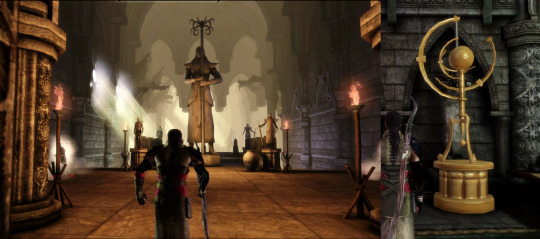
Finally, when you head to the deepest bottom of the ruins, you find a big statue I can't establish to what culture belongs yet; I speculate it's Tevinter due to the places where I found it most of the time. It has a similar flavor to the ones found in Kirkwall.
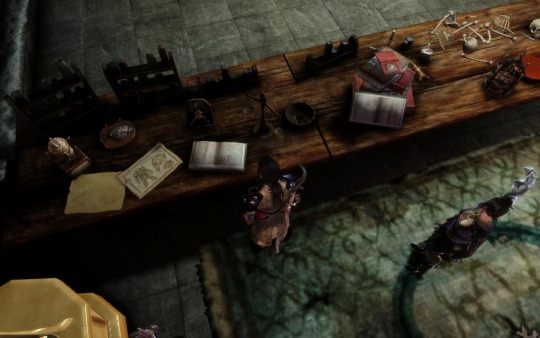
Behind it, an instrument with two tables filled with research stuff. The instrument is something that I can't decide if it is the same artefact we use in DAI to strengthen the Veil, those elven artefacts, or it's a prototype version of the Tevinter artefact to see the stars: the astrarium [which would make NO sense in the deep bottom of the Ruins, lol. What stars are you looking at?].

In any case, after this part you find a big chamber with a quincunx. Probably the first time we see this organisation. Which makes us remember Solas Tarot Card: the thing we find in a quincunx’s centre tends to be of great importance.

So, this disposition makes a quincunx inside another one, since each of them is also a quincunx, but its centre must be.... a person? a sacrifice?

And if this symbol were not crazy enough already, the squares have a Chantry symbol in each corner. Not the Imperial Chantry (which won’t be a big fuss) but the Standard Chantry! I can’t believe this is a lack of resources... the sunburst symbol is extremelly important in DA series.
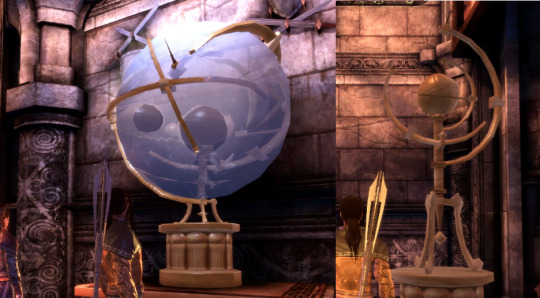

In the centre of this big chamber, once again, we found another artefact that may be an Astrarium or an Elven Artefact. We are sure it's Tevinter, since the same object can be found in the basement of the Circle of Magi. We have no idea what it does, or if it's related to any other artefact we found in DAI. (But it’s related to the one found close to the tables full of research stuff. They look the same, one only has a spherical glass around it while the other is more like the skeleton of the first one, with some missing part)

Anyway, returning to the quincunx Chamber: Here we fight an Arcane Horror. I always found these creatures with a design preeeetty close to the Sidereal Magisters. I don’t know if this means something, but in this context, it hints that a Tevinter experiment went wrong in this chamber and corrupted the mage performing it. It’s not by chance that Arcane Horrors are a product of a Pride demon taking control of a mage corpse. It has a big symbolism.
So, we can speculate that some Tevinter experiment happened here, there is no doubt. Not by chance Zathrian and the Oak tree tell us that the Brecilian Forest has a particular thin Veil, and rage demons possess the trees around. We also find a lot of revenants here (pride or desire demons bound by blood magic, explained in the codex The Black Vials). In short, Brecilian forest has similar symptoms to Kirkwall. Tevinter made experiments here, but it’s not sure if they were performed before or after the slave elves lived here.
Extra minor details
In these ruins is where we found a soul trapped (or bound?) to a gem that will teach us the ancient arts of the Arcane Warrior. It says that it is the last of their kind, implying that if you don’t acquire this knowledge, it will be lost forever and would make no sense for Viviene to have this knowledge in DAI.

All over the Ruins there are some rugs with a symbol that can be interpreted as an oversimplification of the Tevinter Imperium heraldry.
[Index page of Dragon Age Lore ]
#Playing DA like an archaeologist#quincunx#tevinter#dragon#andruil#sylaise#tevinter artefacts#uthenera#brecilian ruins#elven pantheon
43 notes
·
View notes
Text
i love dao because theres always a templar corpse in some fucking situation
114 notes
·
View notes
Text




Dragon Age: Origins | Scenery - Brecilian Ruins
#dragon age#dragon age origins#gamingedit#gamingscenery#daedit#dascenery#desertas.gif#videogames.gif
1K notes
·
View notes
Text
Rook's Coffer.
The rest of this post is under a cut due to length.
[link]
There is a lot of interesting stuff in here. 👁️
A coffer is a strongbox or small chest for holding valuables. The contents of the box is described as being Rook's "personal effects", the "tools of [their] resistance" (against the Evil Gods).
The Light-Up Lyrium Dagger


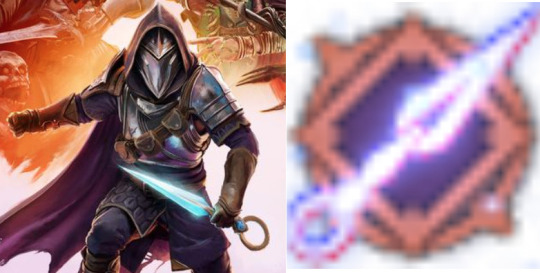
This is the dagger replica that BioWare had on display at their SDCC booth in a case. at the time we wondered if it glows (yes!) and whether it would be a merch item in the Gear Store or part of a collector's edition or something, and here we are. :D the name of the item confirms the idea that it's blue because blue lyrium (I wondered this here). the description on the Gear Store of the item reads:
"Its blade has torn the very fabric of the Veil."
and ~8 months ago I wrote,
"since we saw this image from the 2022 in-game cinematic and speculated that 1. this image shows Solas doing something to the Veil, and 2. the item he’s holding is the red lyrium idol in its ritual-blade form, what it’s reminded me of is the Subtle Knife from HDM (Pullman). Æsahættr cuts windows in the fabric between worlds; I wonder if the idol’s power as a magical ritual-blade is the ability to ‘cut’ through the 'fabric’ of the Veil (of reality), thereby tearing open the barrier that has been separating the two realms."
Cloth Map and Quiver
"Look to this illustrated map to learn about the world you defend."
First let's do the quiver. :>

A quiver to keep a map in is such a cute idea. going by the triangles, it's a replica of the quiver rogue Rooks store their arrows in in the game. ^^
Now the map.

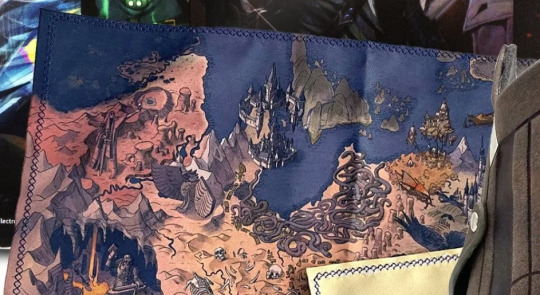

Starting at the bottom right, where it all began~. Ferelden is depicted as a mabari (a symbol of Fereldan royalty), complete with kaddis. You can see the Brecilian Forest and the Imperial Highway snaking round Lake Calenhad. In the Frostback Mountains is the Inquisition’s hairy eyeball symbol, fittingly as that’s where Skyhold is located. North of the Arbor Wilds are the Dales, containing Dalish aravels. Orlais is portrayed as a reclining lion (the symbol of House Valmont is a lion). West and south of the lion are the Nahashin Marshes, the Abyssal Reach and the Tirashan. Across the sea from Ferelden is the landmark of Kirkwall, the Twins of Kirkwall (statues).
The north of the map is the most 👁️ tho, as DA:TV seems to be predominantly set in locales across northern Thedas. That part of the map has a lot of elements from the misted-out northern Thedas map from the Thedas Calls teaser trailer, only.. unmisted. :D we can see the Antivan city of Treviso with its spires and the Antivan Crows flying around Antiva. We can see the giant squid curling over Rivain, this time on a bed of treasure like gold and silver. West of the White Spire mountain is Arlathan Forest, with another aravel, ruins of the city of Arlathan, and floating rocks and floating ruins. in the sea south of Par Vollen is a Qunari dreadnought.
Tevinter is separated from Antiva by the Hundred Pillars. the way they look in this map, they remind me of Drumheller Alberta, where Mark Darrah once mentioned that DA:TV devs went to capture reference material for the game. in this post I wrote of the Tevinter coast that "much of the center is entangled in tentacle-like or snake-like tendrils". in this new map we can clearly see that they are snakes. makes sense, Tevinter is a nest of vipers metaphorically and snakes are part of Tevinter iconography. We can see the city of Minrathous and my all-time favorite guy, Floating Building. Weisshaupt is represented by a griffon and for the Anderfels we have Our Lady of the Anderfels (the statue of Andraste). to the north, Tallo's Eye and the Donarks.
This part of the map is potentially super exciting:

This is a dwarven statue underground in the Deep. the location suggests this is representing Kal-Sharok south of the Anderfels (this is not anywhere near Orzammar, and Orzammar isn't represented on the map by a drawing either). omggg. I really hope we visit Kal-Sharok in this game oh shttt
In the center of the map is Nevarra and the Silent Plains. this map depicts the Silent Plains and surrounds as being full of the ancient bones of giant creatures and giant skeletons. that's 👀 since we saw giant skeletons in Nevarra in the new trailer. we can also see the Grand Necropolis with its eerie green glow as its reaches go down into the ground. it's attended by two [giant?] necromanced skeletons. the gold doodads on their heads remind me of the skeletons we've seen Emmrich necromancing.
There don't appear to be any depictions or landmarks shown in Seheron or Par Vollen. :< and in this last bit of the map it's a bit hard to tell due to poorer image quality that this section of the map is shown in, but east of Rivain is the map compass and south of Rivain, south of Llomerynn, in the whirlpool.. is that an island with an eluvian on it? maybe this represents the Lighthouse and the pocket dimension it exists in? watery Fade imagery and all that.

(Thedas Calls trailer map images below for reference. you can see that 'landmarks' from in that trailer are on this new map)
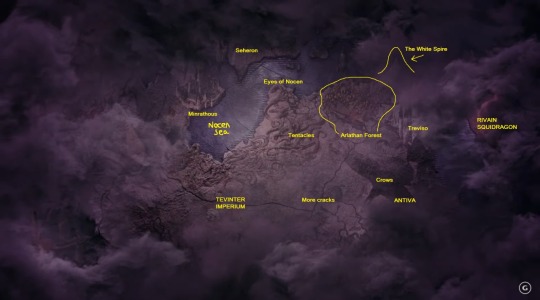



(^ ignore the yellow lines in the Rivain squid cap ^^;)
Rook's Card Deck
"A set of cards depicting people and places from Rook's adventures."
Like the map, there's a lot in these too. first of all the art looks so beautiful and I'm psyched that cards/card-style art is returning in DA:TV, the tarot card art in DA:I was so cool and gave so much inspiration to the DA art community! some of the art is familiar to us, some is totally new.



in this last image we can see that among the cards is the art for the Solas print that came with the BioWare Gear Store exclusive variant of the artbook. the design for the back of the cards is similar to the box for Rook's coffer. for the others I think I'm going to identify them with letters so it makes talking about them easier. ^^ (image without key is above). 26 x 2 = looks like there are 52 cards total, if this image contains the whole set. (if I've mixed up any of my numbers or letters in the below, pls lmk so I can correct it!)

please keep in mind that these are just guesses for fun. [thanku to mime who helped me guess what each card could be :D]
A - Venatori? red like red lyrium and they're always messing with it, diamond shape like their new symbol (two), cult-like vibe, mage robe-vibe. the pointy hoods remind me of the figure in the background of Neve's card. (given the shape in the background, is Elgar'nan messing with them or are they working for him? they could be without knowing he's an elf) B - dragons, dragon fights? (looks like a giant toothy dragon maw bearing down on a party) C - F qunari Rook? (like how there was a card for M and F of each lineage Inquisitor in DA:I. F qunari Inky for comparison) D - Harding companion card art from the Dragon Age website E - Veil Jumpers? gold, triangles, antler/halla-horn type pattern, looks like the person has a glowing gadget F - Grey Wardens? silver plate armor, Joining Chalice, shield with griffon wings on it G - Rogue Rook/rogue class (like there was a class card for each class for Inky in DA:I. Rogue inky) H - one gender of elf Rook? (like how there was a card for M and F of each lineage Inquisitor in DA:I. elf Inky cards for comparison) I - Arlathan Forest? it looks like it has ruins and floating rocks J - 'Fen'Harel' Solas from the in-game cinematic that we saw in this trailer K - Neve companion card art from the Dragon Age website L - Weisshaupt in the Anderfels (see this concept) M - Warrior Rook/warrior class (like there was a class card for each class for Inky in DA:I. Warrior inky) N - M qunari Rook? (like how there was a card for M and F of each lineage Inquisitor in DA:I. M qunari Inky for comparison) O - undead, giant green glow skeletons? P - ? Q - Minrathous R - Lords of Fortune? they have Taash vibes. blue sea in the background, gold trinkets at their waist, swashbuckling vibe S - ? T - Emmrich companion card art from the Dragon Age website U - another gender of elf Rook? (like how there was a card for M and F of each lineage Inquisitor in DA:I. elf Inky cards for comparison) V - red lyrium darkspawn W - M dwarf Rook? (like how there was a card for M and F of each lineage Inquisitor in DA:I. M dwarf Inky for comparison) X - Bellara companion card art from the Dragon Age website Y - Elgar'nan from back in the day before being Blighted? bald like ancient elves sometimes are shown, maybe the orb is his foci. Z - ? not sure, but something bad and maybe red lyrium-related. also blood and maybe an eluvian in the background
[block character limit text break!]
1 - Ghilan'nain from back in the day before being Blighted? creepy tentacle-vibe hair. 2 - Mortalitasi / Mournwatch 3 - ? not sure, but something bad and maybe red lyrium-related 4 - 'Humble apostate Solas' from the in-game cinematic that we saw in this trailer 5 - Blue lyrium dagger 6 - Red lyrium dagger 7 - Davrin companion card art from the Dragon Age website 8 - Taash companion card art from the Dragon Age website 9 - Grand Necropolis. undead city vibes, the eerie green glow 10 - part of this concept art posted on Halloween in 2021. (I think this may be somewhere in the Anderfels/Weisshaupt surrounds after something bad has happened. those creatures are red lyrium-afflicted darkspawn. the location has the same dark/night-time corrupted/Blighted vibe as here, complete with Blightsacs and red lyrium darkspawn. the bad dark Blighted ruined vibe is also like here from the Thedas Calls teaser, where if you zoom in there's some red in the image. when this image was shown in Thedas Calls, it was the segment about Weisshaupt and the Wardens. in the release date reveal teaser, we see a shot of the Anderfels in the day-time without Blight/before anything bad has happened. it looks nice and is a beautiful view. you can tell that is the same place as here because of the presence of the posts with the basketball hoops on top of them. lastly, in the companions reveal trailer, Davrin is shown fighting red lyrium darkspawn in the dark/night-time corrupted looking area, and in the background is a statue of a griffon. 11 - ? not sure, but something bad and maybe red lyrium-related 12 - this Solas art from the Gear Store artbook exclusive variant pack 13 - Treviso in Antiva (see images here) 14 - Elgar'nan? curving horn shape, eclipse 15 - demons? or Elgar'nan and Ghil in their prison together? 16 - Qunari, as in from the group that have been invading/occupying? 17 - mage Rook/mage class (like there was a class card for each class for Inky in DA:I. mage inky) 18 - The Dread Wolf? or the Dread.. wolves. there are 2 wolves in this. Two Wolf Moon 19 - Lucanis companion card art from the Dragon Age website 20 - F dwarf Rook? (like how there was a card for M and F of each lineage Inquisitor in DA:I. F dwarf Inky for comparison) 21 - the Deep Roads (concept art for comparison) 22 - ? but they are this figure from the full cover art of the regular edition of the artbook 23 - Ghilan'nain? horrible centipede creature, suggestion of Ghil's head-shape, suggestion of hands and faces 24 - feather. griffon feather? to represent Assan? 25 - Rivain. boats, sea 26 - Antivan Crows
I feel like I've made mistakes or missed something though because if there's a card for each faction, where is the Shadow Dragons? and if there's an M and an F card for each lineage Rook, where are the human Rooks? I'll revisit the cards and my list again sometime with fresh eyes. :D
One thing I wanted to highlight at the end of the section on the cards is the blue lyrium and red lyrium dagger[s].

Above we talked about how the item name Lyrium Dagger confirms the idea that the dagger is blue because blue lyrium (I wondered that here). in the same post I wondered about the other dagger that we first saw on the deluxe artbook cover:
"This artbook cover one is more gnarled in appearance and the 'ring’ of the handle isn’t complete. It has extra spiky bits protruding off it too and it looks like something is growing on it. Maybe this is what happens if/when the blue [lyrium?] dagger becomes red (Blighted)? because this gnarled kinda vibe reminds me a bit of Meredith���s sword Certainty in DA2, and of that body horror way in which red lyrium growth looks on people. It also reminds me of the tendrils of Blight corruption on walls and the ground and stuff in DA:TV screenshots, and the gnarled red lyrium darkspawn we’ve seen (look at this darkspawn’s back for example). Or maybe there’s simply more than one dagger?"
and here we are. 👀 the blue lyrium dagger Blighted to red lyrium, or else there's a red lyrium dagger out there too somewhere.
Enchanted Die
"This beautiful die will help guide you through the perils of conversation."
The Gear Store description for this item makes perfect sense as the symbols on the dice are the dialogue wheel icons. :D here we can see Romance, Anxious, Sad, Warrior, Investigate, Mad, Stoic and others. also I love the iconic purple-theme color of the dice. :)

Glass Potion Flask
"A decorative vessel that would be essential for storing healing potions."

I have no comments on this really other than it's pretty and that I think it resembles the design of healing potion bottles in the game. :)
Dragon Age™: The Veilguard Companion Lithograph
"This art depicts the faces of your closest allies, the ones who'll stand beside you against impossible odds."
This features the companion art pieces from here.
Thank-You Letter
"A note of gratitude from the creatives at the helm of Dragon Age™: The Veilguard. (From game director Corinne Busche and creative director John Epler)"
and this is a lovely and thoughtful idea 🥺 .. maybe it's the inscription inside the box with the Veilguard symbol?

Lastly there's the box!


It's pretty and is in the same style as the UI on e.g. the skill trees. it looks like there's a square with each companion round the outside, plus a square for Manfred, Assan, and Varric. the gang's all here. :D for the 7 companions, their image is from their 'tarot style' art, but for Manfred, Assan and Varric it's art we haven't seen before. around the outside is also each of their weapons, like an arrow for archer Harding and Lucanis' fancy rapier-sword. I guess in the middle the helmet represents Rook. (it gives me Warden vibes. maybe it's a version of the helmet Rook wears here?).
As a last thought, with the items being Rook's "personal effects", the "tools of [their] resistance", I really love the idea that they have a deck of playing cards and a dice/enchanted dice. I know these are common fantasy world items but idk it's giving a lil, Remy LeBeau. I dunno, Rook somehow has a rogueish kinda vibe to me (as in the trait, not the class). Varric describes them as clever and adaptable, words you might apply to a trickster. "You don't know when to quit" implies a certain incorrigibility. rooks are corvids which have trickster lore irl, and characters that play games with cards and roll dice often have that smart, rogueish, trickster kind of edge in tropes and stuff. it works in my brain in different scenarios too, like if Rook is a foil to Solas, or someone advised by Solas (trickster-mini trickster mentee), or someone opposed to Solas (takes a trickster to outwit a trickster), and/or someone who is in some kind of a way a sorta successor[?] to Solas in terms of story role or repeating history or foils again etc (if you remember the line "They call me the Dread Wolf. What will they call you when this is over?"). you know, like think about what is said about Fen'Harel today and was said about him immediately after the fall (elven voices in Vir Dirthara in Trespasser). what will they say about Rook when this is over? hope that paragraph made sense :D
#dragon age: the veilguard#dragon age the veilguard spoilers#dragon age: dreadwolf#dragon age 4#the dread wolf rises#da4#dragon age#bioware#video games#long post#longpost#solas#thanku to mime who helped me guess about the cards :D#if you have any corrections or other ideas about the card guesses lmk ^^
153 notes
·
View notes
Text
Let's talk (some more) about the Red Lyrium Idol
So, if there's anyone who actually read all of this and is for some reason still interested in even more ramblings, here is Part 2 of my way too long tinfoil theory/summary post about the red lyrium idol, and I swear, it's the last one. 😂 Again, I just needed to get this out before we might get the first real trailer TOMORROW and I'm proven completely wrong, because that's just so funny to me. lol
(Note: This post was written before the title of DA4 was changed into "The Veilguard", so the implications of this title for the narrative were not taken into account for any of this. 💀)
The Phylactery Theory
"A phylactery is a vessel, often a glass vial, containing the essence of a magical being. The Circle of Magi and the Chantry use small phylacteries filled with blood, to track down mages that turn apostate."
"Phylacteries, ironically, are a form of blood magic. When a templar wishes to track down a fugitive mage they will use the phylactery as a way of homing in on the fugitive by way of a "hot and cold" situation, i.e., the phylactery glows, becoming brighter the closer it gets to its respective mage."
In Tevinter Nights, the Carta assassin described the idol to feel rather heavy, like there was "liquid inside". In the 2018 teaser, we see glowing cracks creeping up the idol's surface.

Inquisitor: "You don't need to sacrifice a slave's life to make a dagger." Solas: "I suppose it depends upon the dagger."
(- Solas when talking about blood magic)
In DAO, the Arcane Warrior specialization can be unlocked while doing the "Nature of the Beast" quest line, in the Lower Ruins of the Brecilian Ruins, south the Elven Burial Chamber. Inside a small chamber which looks like a ruined library, there is a broken stone altar. A phylactery is hidden in the far corner of the room. When you touch the phylactery you experience the memories of an elven arcane warrior who has remained trapped inside of the phylactery for centuries. It offers to teach you the secrets of the arcane warriors in exchange for setting its spirit free by placing the phylactery on an ancient altar.
In the "The Hunt of the Fell Wolf" poem in JOH, there is an idol that seems to possess a spirit that is connected to a demon wolf in a way that he can only be defeated if both him and the idol/spirit are destroyed and struck down at the same time.
As demon-stone was shattered, Ameridan struck true: Beast and spirit—both felled at once, Though neither hunter knew.
The Black Vials are six small glass phylacteries that can be found around Ferelden. When the Warden takes a vial, the glass fractures and releases a hostile revenant. A revenant is a form of undead that is created when a powerful demon, usually that of desire or pride, possesses a corpse. Upon their death, each revenant drops a scrap of vellum/codex entry that reads:
"Bound by your true name, no mortal hand shall reach you."
In the Tevinter Nights story "Genitivi Dies at the End", Rasaan and the Qunari were searching for Solas' "true name".
In the final chamber of the Solasan temple, there's an ancient inscription that reads:
Faintly carved into the stone is a figure bound in chains. Two other figures have turned their gaze from the central image. "Pride in our accomplishments and in our hearts. That same pride became (a word meaning corrupted or altered) within him, he sought to claim (indecipherable), cast from favor and so he was bound." "Hidden from mortal eyes, death lies within."
A codex about an encounter with a revenant, 5:71 Exalted:
"[…] The descriptions of the creature's abilities were eerily similar to those our brothers at Marnas Pell encountered almost a century ago […]"
Solas' hideout in The Missing was located in the Deep Roads beneath Marnas Pell.
Cole's comments in Trespasser suggest that Solas was bound to Mythal.
"He did not want a body, but she asked him to come. He left a scar when he burned her off his face."
While Solas seemed to have burned her vallaslin off his face, could there be a chance that he is still bound to Mythal by his true name? Could it be that he is still bound to whatever part of Mythal is trapped within the idol?
Again, the ancient spirit in DAO can only be freed from the phylactery if it is placed on an ancient altar.
So, the question is, if the idol is indeed a phylactery containing Solas'/Mythal's blood and a part of her spirit that needs to be placed on its original location/altar to free her, and if it was ripped off its original location, then where did it originally belong?
The Place Where It All Began
In 2018, we got the first DA4 teaser, showing the idol in various close-ups as well as the focal point of this mural.
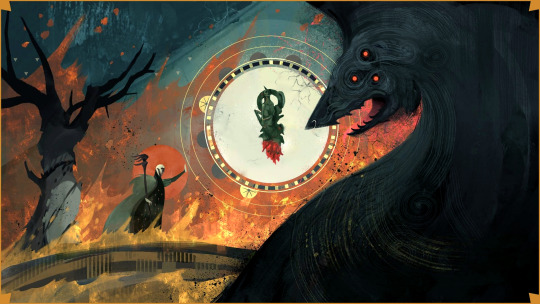
Look at how the idol is suspiciously placed in the very center of the circle/tambourine which we assume to represent the Veil.
Now, what else sits at the center of the Fade that is ever present and visible but cannot be reached?
Right, the Black City.
Again, the idol is very likely depicting Mythal's death.
Now, tell me, where do you think was Mythal murdered?
Or rather, where do you think did the Blight originate?
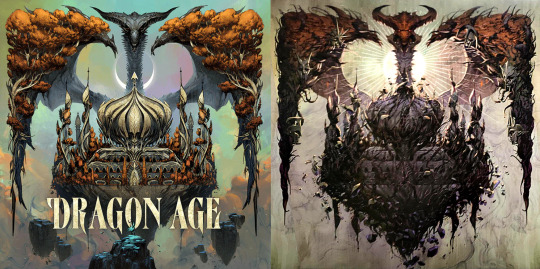

I'm convinced that the Black/Golden City is/was Arlathan. The place where the false gods were imprisoned when Solas created the Veil. The idol/blade was likely forged after Mythal died. The 2022 cinematic clearly shows that the Blight started to spread from the center of the Golden City before it turned black and began to consume the rest of the world, but seemed to have then been contained by the Veil preventing it from spreading further.
"Had I not created the Veil, the Evanuris would have destroyed the entire world."
Corypheus is physically covered in red lyrium. We can assume that he turned into a blighted creature when he entered the Black City, which was already black and corrupted when they opened its gates.
Red lyrium only began appearing throughout the surface of all of southern Thedas in crystalline nodes following the opening of the Breach.
In Future Redcliffe, a year has past with the Breach still open and the red lyrium has spread everywhere.
It is proven that the Veil is inedvitably getting weaker alltogether, and that it will eventually come down at some point, regardless of Solas' actions.
The Veil getting weaker correlates with the Blight spreading further. If the root of the Blight lies within the Black City, and if the Blight was contained/prevented from spreading further through the creation of the Veil, and if the seven Old Gods are connected to the seven imprisoned, tainted Evanuris and serve as seals to the seven gates/mirrors of the Black City, then this banter and these visuals make a lot of sense:

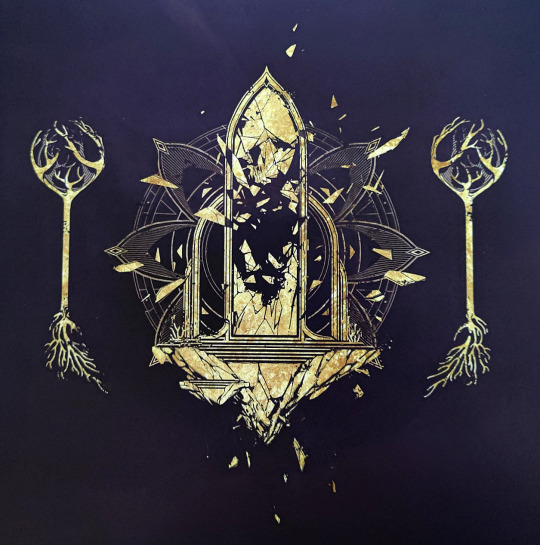
Seven semi-circles with two of them still “lit” and the “tambourine”/Veil looking more broken with each new update….
Seven Old Gods/Evanuris that were banished when Solas created the Veil…..
Seven mirrors shattering….
Seven gates of the Black City, which Kordillus Drakon prophesied will someday shatter and cover both the mortal and spirit realms in darkness….
Solas: Your Order… the Grey Wardens… Blackwall: What about them? Solas: The Wardens see themselves as the world's defense against the Blight, do they not? Blackwall: Yes… why do you sound so skeptical? Doesn't everyone know this? Solas: When an Archdemon rises, they slay it. What will they do when all the Archdemons are slain? Blackwall: Retire? Solas: Without Archdemons, there can be no Blights. Is that the reasoning? Blackwall: Right. Where are you going with this? Solas: Nowhere. I hope they are correct.
Varric: Give [the Grey Wardens] some credit, it's not like you can study the Blight safely. I may not like everything they've done, but without the wardens, we'd all be blighted by now. Solas: They've bought us some time, I will grant them that.
DA4 will likely be set ten year after the events of DAI. And the Veil has gotten even weaker/Solas might succeed in tearing it down.
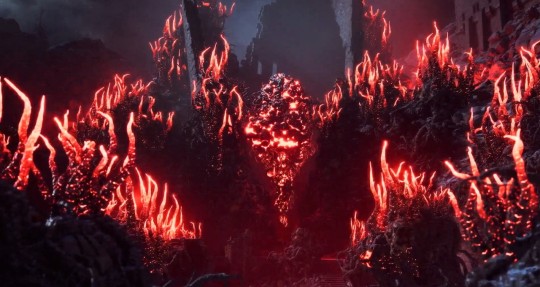

In Tevinter Nights, Solas claims that whatever he's going to do will "save this world".
Maybe the idol will solely be used to destroy the Veil and merge the World and the Fade, in order for him to, quote, "casually reshape reality".
BUT, you know what was proven to be the ultimate power source for Dreamers to reshape reality in a time before the Veil?
Say it with me.....

Great. Dragon. Blood.
So let's go back and assume that the idol is a phylactery that contains some part of Mythal/blood and that Solas is somehow still bound to by his true name. Mythal was likely murdered in the Black City, which might've also been the catalyst for the Blight. Solas might want to enter the Black City with the idol. Again, the ancient spirit in Origins can only be freed from the phylactery if it is placed on an ancient altar.
So… What if Solas plans to bring the idol back to its original location and free her spirit?
The Mother's Return
"Why did Mythal come to you?" "For a reckoning that will shake the very heavens."

At last, let me put on the tinfoil hat one final time and break this all down.
*takes deep breath*
The fact that it is Mythal's mosaic that is revealed to be on the platform in that final fight with Corypheus (symbolically surrounded by red lyrium!), the same ruins that were once the foundations of the Temple of Sacred Ashes.

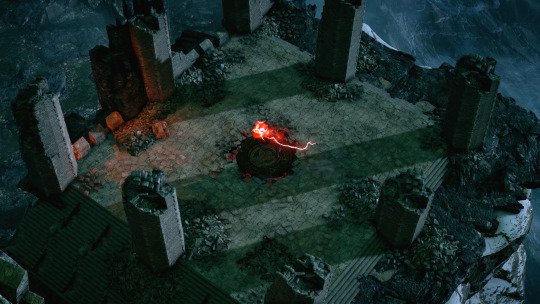
The Sacred Ashes of Andraste, which possesses healing qualities "unsurpassed by even the most powerful spells".
Andraste, who was said to be too weak to bear children, but then miraculously was able to give birth to two daughters later in life. Almost like something came into her life that enabled her to do so. Like, for example, drinking the blood of a Great dragon.
Andraste, who might have not only been a mage, but also an Old God Baby like Kieran, carrying the soul of Dumat.
Old God souls, which a certain person seems to be particularly interested in collecting.

Not the Maker, but Mythal being drawn to Andraste's Old God soul, like a moth to a flame.
Andraste becoming Mythal's host, but that host ultimately burned at the stake, so she had to find another one.

Fast forward a few hundred years. Mythal has found another host in Flemeth, who just so happens to make a bargain with Calenhad Theirin, making him, again, drink the blood of a Great dragon, to gain special powers, leading him to become the first king of Ferelden.
So she watches the Theirin bloodline, until the fateful day Alistair gets almost killed at Ostagar. So she swoops in again, nudging the course of history by saving Alistair and the HOF.
Next up is Hawke, whom she saves so Hawke could find the idol and free Corypheus, setting the events of DAI in motion.
In DAI, if the Inquisitor drinks from the Well of Sorrows and you listen very carefully to the super creepy background noises while playing the audio backwards, the voices of the Well will tell you to "Stop her" and something else that sounds like "She speaks the Calling".
The Calling. A voice, a song, dreams that will haunt the Grey Wardens. Just like a certain idol does.
The Calling, which will force the Grey Wardens to go mad and join the Darkspawn as a collective hivemind to wake the Old Gods, but only after they consumed the Archdemon's blood in the Joining.
A being controlling people as a hivemind?
Like the Titans guiding their children like a collective mind? Titans, whom Mythal was the first to kill and mine their blood and something else to create bodies for her own people.
"The First of my People do not die so easily." (- Solas in Trespasser)
An Archdemon cannot be killed, because their soul will just transfer to the nearest soulless darkspawn. Transfering the soul. The secret of effective immortality.
How do you kill an Archdemon?
By drinking their blood, slaying them and taking in their soul.
What is an Archdemon/Old God?
A dragon.
What WAS Mythal?
"The new ones are faithful to Mythal, but do not understand what she was in her fullness."

Mythal's entire image is based on that of a dragon, a form that in ancient times was reserved for the gods. Because before the Veil, it was the dragon's blood that gave those dreamers the power to shape reality, so powerful that they came to be worshiped as gods. But, I think, not only had Mythal the chief role in the pantheon because she had great dragon blood within her, but because…
Her true form IS actually a motherflippin dragon.
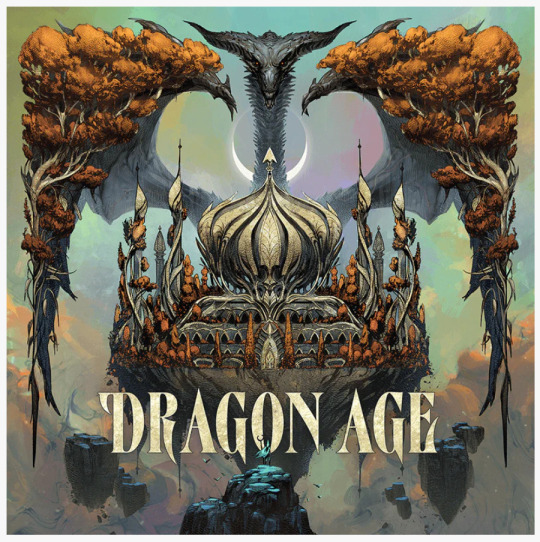
So. What did the Evanuris do in order to KILL Mythal?

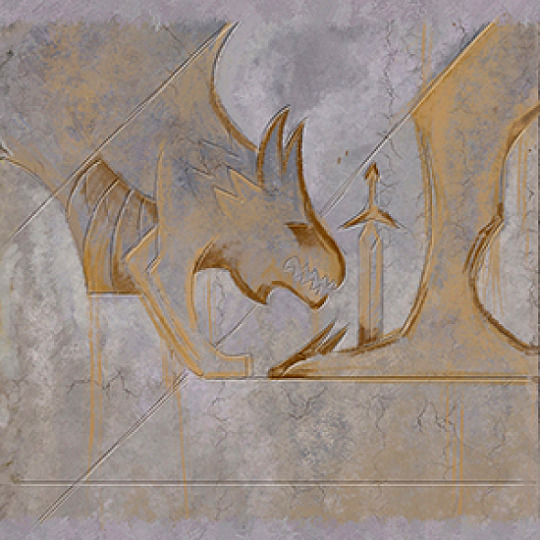
They slayed her, drank her blood and each of the seven obtained a part of her soul, but instead of getting killed themselves, they sought to become essentially invincible through both Mythal's blood and the tainted Titan blood/red lyrium.
Let me quote this wonderful post by @virlath from a few years ago.
With her conquering of the titans, I think it’s likely that her blood is a part of the blight and the red lyrium corruption. Mythal ran the elves' lyrium operations. She had a connection to the titans and their children. She also stole knowledge of the Void from Andruil. Combining all this knowledge it makes sense that she could use this to her advantage once she was imprisoned and corrupted, because she had a connection to both dragon's blood and lyrium. She just needed a physical aspect- Flemeth, and now Solas, to act out her plans. The use of dragon fire in Dark Fortress is further indication that the combination of dragons and lyrium results in a massive power nexus. I think it’s possible that red lyrium is simply lyrium tainted with dragon's blood. More specifically, Mythal's blood. This is why dragons were strictly reserved for the evanuris in ancient elvhen times- because the key to their immortality and power was dragons and more specifically, great dragon's blood. Mythal had strict rules about taking on the form of 'divinity’. I think this was likely because dragons and dragon fire/dragon's blood was the true source of the evanuris' power, and is what allowed them to appear immortal. This could explain why the old gods are so inexplicably linked to the evanuris in the lore. I think the evanuris each had a dragon- an old god, and they each used dragon's blood and dragon fire to make their dreams into literal reality. No one could infiltrate their dreams because only they had access to the power of dragons, which they claimed was their right.
Before BioWare settled on dragons, the Archdemons were supposed to look very different.
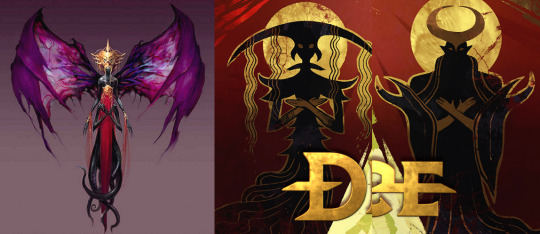
Meaning that, each of the seven Old God souls…. is what?
Yeah, I think it's all Mythal's.
Again, WHAT did the voices of the Well tell the Inquisitor? WHO speaks the CALLING?
It's the voice of the one who's the real owner of that soul. The one who for centuries has been trying to gather the scattered pieces of HER SOUL, driven by nothing but vengeance.
"So Mythal endures."
If the idol contains a part of Mythal, and if Solas used the idol/blade to trick the Evanuris like in Dalish legends, maybe it was because they were desperate to destroy the idol and get rid of Mythal once and for all.
Remember the visions described in Trespasser.
“Hail Mythal, adjudicator and savior! She has struck down the pillars of the earth and rendered their demesne unto the People! Praise her name forever!“ “In this place we prepare to hunt the pillars of the earth. Their workers scurry, witless, soulless. This death will be a mercy. We will make the earth blossom with their passing.” “The runes say the Evanuris fought the Titans. They mined their bodies for lyrium and… something else. It’s not clear.” “They made bodies from the earth. And the earth was afraid. It fought back. But they made it forget.” "For a moment, the scent of blood fills the air, and there is a vivid image of green vines growing and enveloping a sphere of fire." “For one moment, there is a vivid image of two overlapping spheres; unknown flowers bloom inside their centers. Then it fades.”
A sphere of fire… you mean, like the SUN? You mean, Mythal actually creating a MOON, just like in Dalish mythology?

Bear with me here.
We established that Mythal mined the Titan's blood, which I believe was then used for centuries in combination with her fire to create bodies for her own people/spirits. On top of that, I believe that, after her victory, Mythal used part of a dead Titan and lifted it into the sky to use it as a "cornerstone" to build the capital city of Elvhenan, Arlathan, on top of her "enemy's corpse".
I believe that in the moment of Mythal's death, her blood altered the Titan's blood (which also sundered the Song) and that something happened to the moon that she had created, which in turn led to the unbridled power of the sun to corrupt part of the Titan that the Golden City, Arlathan, was build on, as well as both their blood. And that's when it turned black. That's when the Blight was created.
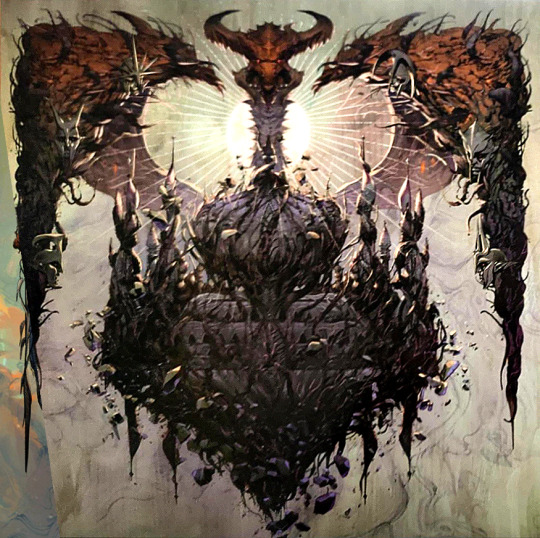
Elgar'nan is the God of the Sun in Dalish mythology. He was likely the main instigator behind the Evanuris' betrayal and Mythal's murder.
The sun imagery keeps appearing throughout DA4's promotional stuff.


If the Old God Lusacan is connected to Elgar'nan, they would represent two polar opposites. The God of the Sun and the God of Night and Darkness. Again, Kordillus Drakon prophesied that the seven gates of the Black City would someday shatter and cover both the mortal and spirit realms in darkness.
"All the world will soon share the peace and comfort of my reign."
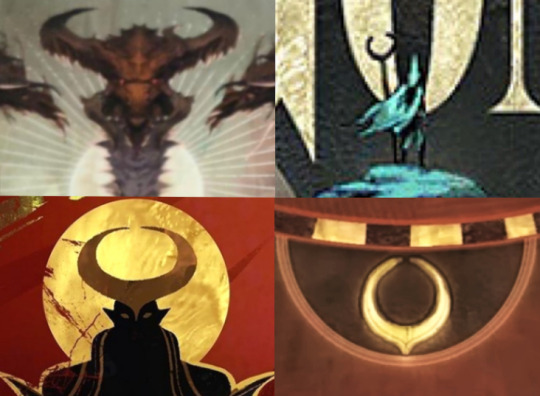
“Lusacan, the Dragon of Night, calls to you. He lives where it is darkest and waits for the day he will rise. Drink of his blood and know the power in darkness: either fear the Night or wield it.“ "The darkspawn yearn to awaken and corrupt Lusacan to start a new age of darkness.” “A night that will never end”
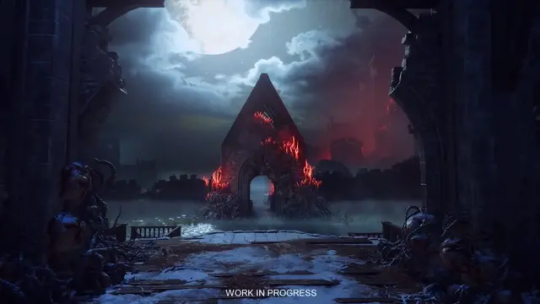


But why does this need to happen? Because Mythal needs to act out her vengeance upon the ones who murdered her and doomed the world with the creation of the Blight.
"She was betrayed as I was betrayed! As the world was betrayed!" "Mythal clawed and crawled her way through the ages to me, and I will see her avenged!"
Solas wants to save his people no matter what, and for that, the Veil needs to be torn down, resulting in the World and the Fade becoming one again…
But, to truly restore his People, I believe that he needs the Mother to come back.
Mythal represents both Justice and Vengeance. If justice is corrupted, it will turn into vengeance. Solas makes no difference between spirits and demons.
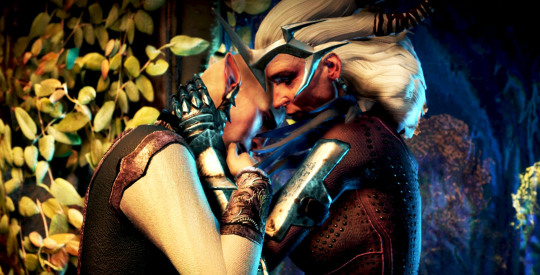
"I am sorry as well, old friend."
That last line of Flemythal to Solas. It's so simple, but what does it truly mean? Why is she apologizing to him?
Is it because none of this would have happened if she didn't die and everything that happened to the people and the world was because of her downfall? Because it was her who started all this in the first place with the death of the Titans, stealing their hearts and corrupting their blood?
With her gone and no one left to keep the false gods in check, if it hadn't been for her death, Solas wouldn't have been left with what seemed to be the only choice?
Is she sorry for everything he had to endure, from her giving him a body against his will, twisting his original purpose, to him having to live with the guilt over the death of a world and an entire civilization for a thousand years?
Or is she apologizing for using him?

"An eclipse as Fen'Harel stirred."
"Cry havoc in the moonlight. Let the fire of vengeance burn. The cause is clear." (- Solas reciting Mythal's invication)
She knew that Solas would do anything at this point to undo his mistakes and save the people he doomed. She knew exactly what Solas would do when he came to her in that after credits scene in DAI. She knew that he would need that power and the idol to complete his ritual in order to tear down the Veil, but to what end?
Without the Veil, whoever controls the dreams controls reality.

#tinfoil time#da4#red lyrium idol#solas#mythal#now on to being proven completely wrong about any of this! 😂
77 notes
·
View notes
Text
Dalish Elf Origin. Now we're getting into the lore that was strongly recontextualized through Veilguard.
Now we're getting into things that directly intersect with the Veilguard revelations. After Andraste's revolution gave the Dales to the Arlathan descendants and then Andraste's church took the Dales back away from them, scatterings of elves refused to join human societies and convert to Andrastianism. They instead went their own way to try and remember what they could of the Evanuris and their true heritage.
Right from the get-go, the first codex entry is about the gods the Dalish worship.
Elgar'nan, Eldest of the Sun and He Who Overthrew His Father
Mythal the Protector
Fen'Harel the Dread Wolf
Andruil the Huntress
Dirthamen the Keeper of Secrets
Ghilan'nain the Mother of Halla
June the Master of Crafts
Sylaise the Hearthkeeper
Falon'Din is missing from the list.
The endgame that the Dalish seem to have in mind is to simply outlast humanity. They're just gonna wait it out until human civilization has collapsed, then reclaim what's theirs.
Though some Dalish are satisfied with what they have now. The "Aravels" codex entry details the journal of Taniel, a Dalish who thinks the elves have it better now than they ever have. Taniel longs for neither Arlathan nor the Dales, but believes that the Dalish are more free as a nomadic people than they've ever been in history.
Considering the history of Arlathan and Tevinter... uh.. yeah, that checks out.
Also, sometimes the Dalish piss off the woods and get turned into trees. That just. Happens. It happened in Arlathan Forest in Tevinter, and it also happened in the Brecilian Forest in Ferelden.
The Brecilian Forest codex entry tells the story of a clan who cut down a tree they shouldn't have. The tree had a spirit living in it and, despite the spirit begging them not to, one of the Dalish cut it down anyway to make bows. The spirits' retaliation made their whole clan into tree statues of ex-people.
In any case, the Dalish origin features the uncovering of a mysterious ancient ruin. Deep in the Brecilian Forest, on the opposite end of the continent from Arlathan, is an old site made from human architecture but with effigies of Elven gods.

Not this. This is a statue is of a woman gently roasting her forehead.
I was referring to this.

According to Tamlen, this is one of the Evanuris, though he neglects to name which one unless you press him on it. It's Falon'Din, the one that the codex forgot to mention.
Creepy, yes, but Tamlen assures the Dalish Elf that Falon'Din wasn't an evil god. He's wrong. Trust your instincts, folks.
(Fortunately for all of us, Falon'Din's been dead since the end of the second Blight, so we don't have to worry about whatever the fuck is being depicted here.)
But the key point of interest inside this ruin is, of course, this.

The Eluvian, which has the truly interesting feature of being guarded by a Blighted bear.
During the investigation of the Eluvian, Tamlen describes seeing a vast underground city and a great darkness. The darkness he's describing is, of course, the Blight. This Eluvian is implicitly connected to one of the lost Dwarven thaigs that the Darkspawn took.
Right here at the very start, a connection is made between the ancient elven gods, the Blight, and the Deep Roads. This temple to Falon'Din has a blighted Eluvian to some ancient thaig.
(Perhaps to his Archdemon Zazikel?)
Duncan, notably, miscredits the Eluvians as being of Tevinter origin. The Wardens are aware enough of Eluvians to know that sometimes they "break", as he puts it. They just... become Blighted out of nowhere, and start radiating Blight to everything that touches them.
(Because the Eluvian network passes through the Fade and the Blight itself also comes from the Fade. The Blight is tainting Eluvians from the other side.)

Also there's an opening to the Deep Roads. Apparently we have Dwarves to credit for that, as the blurb describes them as having "dug too high and too frugal and struck elves".
As the dwarves emerged from the vanquished Titans, it's entirely likely that they didn't realize there was an upper limit on digging at first.
The fun thing about the Dalish Origin is that, although this is not the Dalish clan we'll spend a major chunk of Origins's story with, it is a Dalish clan that we get to know very well in the second game.

Merethari will regret this decision.
Ilen has a bit of history for the clan to share. The Sabrae clan were among the first to flee the Dales during the second collapse of Elven civilization. That would have been around the year 7719, when the Dalish kingdom fell and the Sabrae people fled to the Brecilian Forest.
Upon arrival in Brecilian, the elves made a pre-emptive strike against the barbarian clans of the Clayne Alamarri, who Ilen is confident would have attacked us anyway. Probably not unfounded but it's still worth noting that the Sabrae started the hostility between the Clayne and Sabrae.
Note that this is centuries before the formation of the Ferelden kingdom in 8041. When they say "the Clayne", they mean Fereldans. The Clayne tribes are the Alamarri banns, arlings, and teyrnirs that Calenhad would one day unify into his kingdom.
In a sense, the Sabrae are still at war with the Clayne to this day

There is also a Dalish historian but he only shares the basics. After being freed from Tevinter, we built up the Dalish kingdom and sought to reclaim our lost history and lore. But then the humans were bitter that we didn't worship Andraste and fucked us right up.
Elven legends say that their ancestors were immortal and possessed magic that humans could scarcely dream of.
This is accurate. They're remembering the time before the Veil, when elves could draw on power from the Fade and the Blight. Solas isn't exactly wrong to think that the elves kinda-sorta long for him to tear down the Veil. They don't know that's what cost them so much. But it is, and he's misguidedly accurate in lamenting it.
Codex entries on the fall of Arlathan go a bit more into detail. Ancient elves were eternal and "never-changing", hinting at their origins as Spirits. They drifted through life in slow-motion, in a state where a conversation could last years or even decades.
The elves were here first. Well, the Titans were here first but the elves were here before the humans. They recall the first humans arriving from Par Vollen, the very same island that would become the arrival point of the Qunari.
(Did humans come from the same far-off lands that the Qunari came from?)
The Dalish recounting of Arlathan's history remembers nothing of the Titans, of course. But they do recall a "quickening" effect from contact with humans, whereby the elves' interactions with humans made them become short-lived and mortal as if somehow reflecting the humans' nature.
(Most likely a distorted interpretation of the Spirits deciding that they wanted to become corporeal. Perhaps it was contact with the humans coming in through Par Vollen that set the Spirits' minds to becoming the human-like elves?)
They don't recall the war between the Dread Wolf's forces and the Evanuris. But they do remember the newly arrived humans eventually forging their fledgling civilization into the Tevinter Imperium. And the fall of Arlathan under Tevinter conquest.
They also claim that "human contact" with the Tevinter turned every elf mortal. Probably misremembering the effects of the Veil going up.
They do, however, recall a pretty accurate account of what became of the Evanuris. Fen'Harel approached the "ancient gods of good and evil" and offered them a truce. They would exile themselves to their respective realms and never enter the other's lands.
However, they did not realize this was a trick. Fen'Harel betrayed them and sealed all the gods away forever, and that is why they were unable to come to Arlathan's rescue when Tevinter violence fell upon them. Now Fen'Harel roams the Fade, watching over the prison of the Evanuris to ensure they never escape.
That's... pretty much it, yeah..

Poking around the Dalish camp brings out some interesting bits of lore as well. Despite ostensibly being the sun god, Elgar'nan is remembered for fighting and winning a war against the sun.
According to legend, Elgar'nan was the son of the earth and sun. However, the sun grew jealous of the earth's love for Elgar'nan and lashed out, destroying all the creatures of the earth. Elgar'nan retaliated, attacking the sun. They fought until Elgar'nan tore the sun from the heavens and cast it into a deep abyss.
With the sun's defeat, the sky was left blanketed in shadow, with only shimmering twinkles of the sun's blood dotting the sky. Elgar'nan basically invented night by kicking the sun's ass.
While this is obviously the distortion of mythmaking, it certainly does explain why his Archdemon Lusacan is known as the Dragon of Night by Tevinter.
(Of note: The elves are spirits who assumed corporeal form. The Maker allegedly created the spirits and the Fade first, then went on to create the corporeal world. Elven legend says Elgar'nan ripped his father from the heavens and buried him in the earth. The Maker, if he exists, is missing for reasons unknown. Is this something? IDK.)
All in all, hanging out with the Dalish is fascinating when you know the context behind their legends.
#dragon age#dragon age origins#veilguard spoilers#revisiting dragon age#revisiting dragon age origins
20 notes
·
View notes
Text

Banal Nadas
I wrote this literally years ago, but it actually became canon, so beware spoilers for Veilguard. (I feel powerful, lmao.)
Ilaana Lavellan meets a spirit in the Fade in a moment of anguish--a spirit with a lesson to help her save her beloved.
***
“It was not supposed to happen this way,” the spirit breathes, and it sounds so like him that I am rooted to this patch of the Fade.
“His words,” I say softly, looking around as if I will see his eyes upon me, as I so often have.
“Yes,” the spirit says. “You are here now, and it has happened this way.”
“This is also correct.”
I am in a vast forest, the Brecilian Forest, I think, though I have never seen it in life.
“To find interesting parts of the Fade, one must be interesting.”
“Also his words.” I look at the spirit curiously. It hovers between two enormous ironbarks, titans in their presence, the two trees so close they should never have grown to such size.
The metaphor sinks in a moment too late. I wince.
“Ar lath, ma vhenan.”
Curiosity will quickly become annoyance. I move onward, trying to hold tight to my purpose tonight. I’m running out of time. I’m running out of time.
“Var lath vir suledin!” The spirit is anguished, as I was anguished when I said the words.
I stop. “My words. Why?”
“In another world.” Something of this spirit clearly relates to me and Solas so strongly it seems to want to regurgitate much of our most painful conversations.
“I’ll bite,” I tell it. “Why not this one?”
“You are asking better questions,” the spirit says.
It turns away, in a different direction than I planned to go, but I have made friends with Acceptance, Compassion, Wisdom, Hope. I have even soothed Despair into Resolve. Apathy into Purpose. I am a Dreamer, now, in full. If I am not so skilled as Solas, well. Empires and nations rose and fell while he learnt what I have tried to cobble together in a handful of years with a ticking clock ready to explode the world. Demons come to me to find themselves. Sometimes they try to kill me. Usually I reach for them, and they change. Sometimes they change me, bit by bit.
If this spirit wants me to follow, I will follow.
It moves down a path between trees, and it gains form as I watch, but it holds nothing for long. It looks like him for a moment, then it looks like me. I see him as I saw him in Redcliffe, in Haven, in the ruins, over the broken fragments of his orb. I see myself with my vallaslin, without it. I see myself and Cullen, eyes full of love, under an arch at Halamshiral with Mother Giselle there to marry us. I am wearing a white dress, such a human dress, such a human thing, but with my long-gone vallaslin clear on my face. I am dressed as a sentinel, a Sha-Brytol, a Keeper, a scout. I am resplendent in robes of gold and silver, my hair sparkling with diamonds like stars. He stands proud, Fen’Harel, a rebel god who loves me. My freckles are gone. My freckles are darker, my skin tanned and weathered by the sun. Scars cut through my face. I am missing part of an ear. Solas is scarred with red lyrium that clouds his eyes.
I want to ask, but not yet.
Instead, I simply follow.
The trees give way to the Arbor Wilds, miles and miles away. I know this place. This is where I met Mythal.
“You should not have given your orb to Corypheus, Dread Wolf.”
The spirit looks like her for a moment, and then she is him, as I last saw him before the Qunari plot. He must have traveled by eluvian from Skyhold immediately after we vanquished Corypheus.
He is a broken man, for a moment. He still wears the jawbone I now carry around my neck.
“I wish it could, vhenan.”
This spirit seems to want to speak with our words, so I will let it. With a thought I am crosslegged in the grass, my fingers feeling the blades. They are so green here, as green as they are in life. The Black City is beyond, over the tree line, waiting.
“Tell me you don’t love me!”
“I cannot do that, vhenan.”
I thought I was somewhat prepared, armoured. But that—
Solas stands in front of me in Crestwood, his hands twitching between looking as though he wants to simultaneously crush me to him and fend me off. He is frightened, flighty, two things Solas seldom is.
The spirit reflects that moment, showing me again the precise moment my heart broke, when Solas decided to be Fen’Harel and not tell me himself.
“You do not have to destroy this world! I will prove it to you!”
My voice, thrown by the spirit, echoes through this bower.
“I will treasure the chance to be wrong once again,” it says sadly.
“Foolish wolf,” I mutter myself.
“There is a place where you can build, grow.”
I am growing weary of whatever games this spirit is playing. I relive these words in my mind every day, every grain of sand that ticks through the hourglass counting down to the moment I will have to face…I have no words for what Solas is to me. Some days I trace the lines of magic that remain in my severed arm, feeling out for the Anchor. Those days I hear him ask if it has changed me, my…spirit, as he hesitated to say with the sun setting behind me on my Skyhold balcony.
What if it did? What if the Anchor is the only reason I love him?
“You are you, old blood older than old. Like calls to like even without a cord to bind them.”
The spirit has resumed its state of formlessness, floated closer while I sat in my pool of constant grief.
“Very well,” I tell it. “Why have you brought me here?”
“Banal nadas,” it says, hovering directly in front of my face like a challenge. It is not Solas’s voice I hear, but mine, gentle. I have never said those words, not like that.
“Banal nadas!” The spirit bellows it at me with my own voice again.
My skin tingles like I am in the waking world in a place where the Veil is thin. I have never felt such a thing whilst walking the Fade, not as such.
“I want to help him,” I tell the spirit fiercely. “Our people have suffered enough.”
“Who are your people, Ilaana?”
“That is the question, is it not?” This time it is I who bring Solas’s words to life, another sentence from a Crestwood heartbreak under the watchful gaze of Ghilan’nain. My lips quirk with a cynical smile. “Solas is my people. Cullen is my people. Cassandra and Cole are my people. My friends on this side of the Veil are my people. You, as well. Dorian, my beloved friend. Varric. The Iron Bull. Sera and Vivienne and Thom. Krem and Maryden, Dalish and Grim. Svarah Sun-Hair and Skywatcher. They are my people, spirit. All of them. Abelas is my people. Mythal is my people. Clan Lavellan is my people. Briala. Charter. Samson. Leliana and Neria and Merrill and Hawke. Alistair is my people. The Wardens I exiled are my people. The templars I condemned are my people. Ser Barris. Belle. Gaspard. Mihris. That bloody piece of self-loathing nugshit Michel is my people. Felix and Alexius. Gatt and the Viddisala. Elera and Dagna and Valta and her titan friend. Rage and Despair and Pride and Wisdom and Acceptance and Justice and Vengeance. They are all my people. All.”
I am angry now, angry enough that I feel the energies blazing off me like a pyre. If Solas is walking the Fade just now, he will certainly see me, feel me. We never have had to try hard to find one another here, and I am screaming in an echoing hall loud enough to wake Elgar’nan himself. That stupid prideful Evanuris who likely started all of this, he is my people too, for all he’d scrape me off the bottom of his gilded fucking boot.
“Do you hear me? Do you hear me, Dread Wolf? Dirth ma, harellan, vhen’an’ara—ane emma!” I yell the words into the Arbor Wilds, at the Black City, at any spirit who will listen. “You are all my people, and I am trying to save your foolish, thoughtless chunks of Fade-stuff and meat from yourselves!”
The spirit in front of me looks suddenly pleased.
“An answer a long time in coming, Inquisitor,” the spirit says, almost preening.
“Who are you?” I ask it bluntly. “I am tired of trying to help those who are determined to cut off their own feet because they don’t like the shape of their toenails.”
“Vivid, as always.”
“I asked you a question.”
“You asked a good question. I brought you here to hear, to listen, to scream. Has it helped?”
“A bit,” I admit. I feel lighter. Apparently my quiet footsteps through the Fade were possible because I’ve been bottling up every part of me for so long.
“Good,” says the spirit. “You asked my name, and I will give it. But first, you need to understand the most important thing I have said to you.”
“Which is?”
“Banal nadas,” the spirit says again.
“That one isn’t leaving my memory any time soon,” I say. “Your name, if you please.”
“You carry a heavy weight, as you have for so long, Ilaana. Your name, Ilaana. In the place of sacrifice. How much have you sacrificed?”
“Enough,” I say. My arm twinges. That is the least of it. I am no less than I was for a foot or so of missing flesh. The words I said to Ameridan. It takes everything from you.
“You look ahead with purpose, and you look ahead with grief, because the weight pressing upon your shoulders does not let you breathe.” The spirit looks like me, now. My face, without my vallaslin, with my freckles, the new scar on my nose from some Qunari Sten or another. My dimple. “You cannot see a way out.”
We are back in the forest, a different forest, and the trees are oppressive. They crowd around us, leaning over my shoulder, draping their leaves over my neck. I can almost feel their breath.
“You are telling me everything I already know.”
“You may remember the words, but you need to know, truly know. Eolasas, da’len.”
It changes to Solas’s face in Redcliffe, his eyes pulsing with red lyrium. Its voice repeats his words.
“You would think that such understanding would prevent me from making such terrible mistakes. You would be wrong.”
Anger flares again. I am surprised that this place has not been swarmed with spirits. The trees could very well be rage demons, every one.
“I couldn’t stop him,” I tell the spirit, and with those words, my anger cracks in half. In its core is only sorrow. “He left. He left again. He left again, and he called me vhenan.”
“Yes,” the spirit says. “He has done these things. Over and over, he has done these things. He is as trapped as you are. But the trap is of your own making. Time is no flat circle, da’len. You are thinking in too few dimensions.”
I sit in silence for a time, feeling at the edges of my hurt. I long for Cole’s comforting presence. He is somewhere in the Fade. I suspect he is with Solas. He told me he had to go where he was most needed. Or perhaps Cole is simply with the other spirits, sharing himself with them, preparing them. Where he is most needed. That would be a very Cole thing to do.
Everything that has happened has happened. I could not stop it.
“Banal nadas,” the spirit says again, insistently. “You make a tragic mistake, Inquisitor. Ilaana, da’len, da’lath’in. You must listen. You must see. What are all of these voices, save one?”
The one the spirit is speaking of must be my own, yelling its words. The rest are—
“Memories,” I say flatly. “Reminders of my own failures. I should have told him in Crestwood that I knew—”
“He would have fled. Likely, anyway. Banal nadas,” the spirit says, this time almost as if a joke. “Your instinct held your tongue because you knew him to be afraid. You yourself were afraid, thought you could keep him near a while longer, that it would give you time you had no way of knowing was running out.”
“Yes,” I say. “And then he was gone.”
The weight of the jawbone against my chest is usually a comfort, even in the Fade. Not now, not really.
“What is a memory?” The spirit asks me this as if it is speaking to a very dense rock instead of a person.
“A fragment of perception rooted in a moment in time that has passed,” I say.
“Time that has—” the spirit leads.
“Passed.” I stop, looking at it. It looks like me again, hopeful. It looks like I looked when he asked me to dance at Halamshiral, that horrible night, that wonderful night, that night that gutted me from the inside and built me anew all at once.
The night I learned my lover's true names.
“Before the band stops playing, vhenan, dance with me.”
His hand outstretched to me, his smile full of love. Moments before, the easy pressure of his hand against my shoulder, a comfort, knowing I needed his touch more than anything else.
“The past,” I say slowly. “Banal nadas.”
“Yes,” the spirit says, and the trees pull back from their crowding, letting through a burst of air, cool air, memory of a spring breeze. “You carry the weight of it, and you let it lead you, but you are letting it press you into the ground, da’len. You are like him. Like calls to like. His past weighs him as well, and it will crush you both, the past, if you let it.”
“You make it sound like…” I trail off.
I’m being obtuse, now. Of course I’m being obtuse.
It is easier to believe I cannot prevent whatever happens. It is easier believing, accepting, resigning myself to fatalism. Whatever will be will be. I remember what Acceptance said to me so long ago, that it could see many paths for itself without becoming any one of them. I have forgotten that wisdom. I have let myself become the one thing I cannot bear because some part of me thinks it is easier than believing I could build it better instead.
“I am frightened,” I say. “He said he walks the din’an shiral. He chose for me, and I am furious at him. He said he could not do this to me, but he will do it to himself. He says he will, and he condemns me to accept it. But what he accepts, I do not have to.”
“Yes, da’len, continue.”
“I am afraid.” Afraid does not even come close to what I feel. I am half a breath from shaking to pieces.
“I know, da’len.” The spirit looks like Keeper Deshanna now. It sits in front of me wearing June’s vallaslin.
“I have said I will save him, that I will prove to him, but I haven’t believed it. I haven’t been able to believe it.”
“Your love for him is so deep that it reached me in the farthest depths of the Fade,” the spirit says softly. “You are on the shore watching a hundred-foot wave threaten to crush you, and you believe if you run, if you fight, if you try and do something, it will wash you away no matter what. It is easier for you to believe that what is past will dictate what is future.”
“Yes,” I say. “You are correct.”
“But that is not how anything works, da’len. It may seem it sometimes, but do you know what it took for him to see you at all? How many ages he lay sleeping in sorrow, walking paths with friends but seeing nothing of himself wherever he looked?”
I shake my head.
The grove around us is quiet, peaceful now. It is the grove in the Dales, the one where we once moved together with our magic, our mana, our staves. It is the grove where he gave me his glyph-chilled water and I wiped a droplet of it away from my cheek and he told me that he had yet to see my indomitable focus dominated.
I wonder if it has been as fascinating as he expected, watching me crumble under our combined pasts.
“A thousand thousand variables, a weave of time and circumstance more delicate than the Veil itself,” the spirit says. “You are real, and it changes everything, but it can’t. Do you not hear the contradiction in his own words?”
“Yes,” I say.
“You are real, da’len. You are real, and you change everything.”
His words, and the spirit’s. They mould to something in me that I have not felt in months. I have felt this future bearing down on me like the wave in the spirit’s metaphor, ready to crush the life out of me, out of my people—our people—and the person I love enough to save. I have waited for him enough. Atisha, Ilaana.
I breathe slowly, my mind clearing. His words, to me. In hindsight they feel both inevitable and deeply cracked, waiting to be moved in another direction.
“Yes,” I say, this time because it is the only right word to say. “Thank you. Thank you, hahren.”
“Nuvu lasa su ma enaste, da’len.”
“Why have you done this for me?” I ask. It still has not told me its name.
“You are not the only one who loves him,” the spirit says simply. “I would not watch him suffer more. I would not watch the weight he carries grow. And he is not the only one who loves you, da’len. I would be remiss if I did not try.”
“You are saying—”
“I am saying banal nadas.”
Yes. Yes.
Banal nadas.
Nothing is inevitable.
“Thank you,” I say again. “Ma melava halani.”
“Sathem lasa halani,” the spirit says. “And now you must go. You have a great deal of work to do.”
“Wait,” I say as the spirit rises, once again formless, shifting every time I blink. “You promised me your name.”
I wait for a moment, wondering if it will be Hope. Faith. Even Love, something as simple as that.
The spirit looks like him once more, and it reaches out to touch my cheek the way he so often has. It tugs his favourite curl.
“Possibility,” the spirit says.
I wake.
***
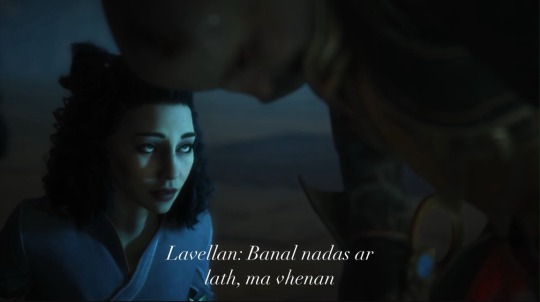
Lavellan: Banal nadas. Ar lath, ma vhenan.
#solavellan#solavellan fic#veilguard spoilers#solas#solas x female lavellan#solas dragon age#solas x inquisitor#solavellan hell#dread wolf#fen'harel#dread wolf's redemption
32 notes
·
View notes
Text
have we considered a rogue or warrior Mahariel who frees the elven spirit in the Brecilian forest ruins and it teaches them the Arcane Warrior specialisation. and they can't use it, because they're not a mage, but they hang on to the knowledge until Awakening when they meet Velanna and then they get to pass on this ancient knowledge from their ancestors to a Dalish elf who will actually use it and appreciate it
321 notes
·
View notes
Note
peekaboo 🪨📚🌊🕐 for ozy imbris and cian 💃💕
thank u!!! | yet another oc ask game
🪨 Someone gifts your OC a shiny rock. What do they do with it?
ozy — ozy has in fact been gifted a rock before, considering his party member scratch is obsessed with them. he would (and does) keep them in his pack with the couple of other mementos deemed precious enough to hold onto, and for a long time he wears the first one scratch ever gave him as a necklace.
imbris — if it's shiny he's definitely keeping it for as long as he can justify the space it takes up in his pockets! he loves a shiny bauble
cian — this boy treasures any kind of gift. he'd keep it in his pack or use it as a worry stone, wearing it steadily smoother and smoother.
📚 Your OC has to improvise a 10 minute lecture about a topic of their choosing. What do they chose?
ozy — honestly probably something to do with martial combat or fighting styles. he doesn't feel qualified to lecture anyone on anything aside from that, and the things he actually thinks about most deeply are not really lecture material
imbris — his own Top 10 Daring Escapes From the Law (modern AU imbris could talk about skateboarding or video games for hours)
cian — hmm the medicinal applications of local ingredients? triage for beginners?
🌊 Has your OC ever seen the ocean? If not, do they want to? What do they think of it?
ozy — he went almost a century between visits to the ocean, and when he saw it again it was on another planet and full of corpses and aberrations. he sorely needs to visit the ocean properly but i think that sits unaddressed on his private list of priorities until someone else suggests it post-campaign and he's like "yes please i don't know why but i'm desperately craving salt water"
imbris — yes! big puddle innit. (it tugs a little at his gut the way the open sky does, but he's intimidated by the ocean in a way he isn't by the air. he'd still love to board a ship and stand with his face turned into the wind though. i think he would've been a great pirate in another life)
cian — he saw it for the first time in athras' care when they visited some ruins at the very edge of the brecilian forest, where it touches the east coast of ferelden. he thought it looked vast and beautiful and dangerous and a little haunted. when he crossed the waking sea to escape ferelden it confirmed all his suspicions (he has weird dreams over open water)
🕐 Was there ever a time your OC would have given everything to turn back the clock 5 minutes? What happened?
ozy — when his husband vael died, shot through the neck with an arrow, he wished he'd stopped it. when he stood at the gates of emvalin watching the towers plummet from the sky, hearing elora's sending cut off mid-sentence, he wished he'd been there with her. when daichi sacrificed himself to close the abyss portal he wished he'd been a little bit quicker (though granted he tries to let that regret heal, as per daichi's instructions)
imbris — the first time his father hit him he wished he could go back to the world before it happened. nothing was ever the same after that.
cian — you know very well he wishes he could go back to before the barn burned!!! also 10000% after val foret he wishes so badly he could go back and do anything to avoid that outcome.
#ask#in-maidjan#ch: ozymandias#ch: imbris#ch: cian#ozy's regrets about the abyss portal situation were 50% 'dai deserved better' and 50% '/My/ Purpose Was To Die There Dammit'#he'd only Just found clarity again and decided this was his purpose and dai got there first!!!!#deprived of self destruction by someone else self destructing faster than you 🙄
8 notes
·
View notes
Text

(from amirdrassil's datamine google doc) it's interesting to me that originally cyrian's mask is basically the phylactery of anaris. it makes sense, given that the explanation of it in-game (elven gods used masks like this to control their servants, except it doesn't actually control servants, it just lets them feel their master's emotions, except not all their emotions) does feel very reverse-engineered from "cyrian has a mask that is affecting him but not controlling him."


i do wonder why they changed it... maybe it was decided that it's not lore-compatible? it sounds actually pretty similar to the ancient elven spirit who is trapped in a phylactery in the brecilian ruins in da:o (and can teach the warden the arcane warrior specialization). however, notably that ancient elf is inside a phylactery, meaning it's probably blood magic (and not just an enchantment on an object).

if i really had to guess why they changed it, though, i would assume it's because they wanted anaris to be able to manifest in-person. if he's inside cyrian's mask, then a) we wouldn't get to see anaris walking around, and b) presumably the anaris boss fight would have to be against a possessed cyrian? unless the "ritual" was to create a new physical form for anaris, and not just to turn a bunch of veil jumpers into demons. maybe out of lyrium, since we discover in this game that's how the first elves created physical bodies for themselves? it would certainly have been a way to meld bellara's fixation on the fate of the titans with her personal quest.
#veilguard spoilers#cyrian lutare#anaris#the forgotten ones#bellara lutare#at the end this veers away from speculation and just becomes pure imagination#also disclaimer that i understand cut content isn't canon or was even ever intended to be implemented in the final game#but it is interesting to see original pitches for things that make sense of stuff that's confusing in-game#veilguard in many places feels like a game of telephone that never had a chance to be fully polished and made internally consistent
9 notes
·
View notes
Text
DA Hero Profile: Theron Mahariel
to begin my official tumblr posts about my DA heroes, why not start at the beginning with my canon warden; Theron Mahariel!

Full Name: Theron'Nehn Mahariel
Name Meaning: "Theron" is the default name for a male dalish warden and then I added "Nehn" at the end to make it sound cooler
Age: 42 (as of DATV)
Birth Date: 1 Harvestmere, 9:10 Dragon (Oct. 1st) [Libra]
Origin: Dalish (Clan Sabrae) / Ferelden (Brecilian Forest)
Gender Identity: Cis Male (He/Him)
Sexuality: Bisexual
Class: Rogue (Archer)
(backstory and game-based lore under cut!)
Dalish Origins
Theron was the second child of Keeper Athelen Mahariel and Sulevin Lavellan, born three years after his sister Ellana. A year after his birth, he and his sister would be orphaned after their father was murdered by human bandits and their mother abandoned Clan Sabrae in the aftermath, leaving them to be raised by their paternal uncle, Amerlen. Under the suffocatingly-traditional upbringing of their uncle, Theron and Ellana would be educated in every aspect of Dalish life, as well as being shown the ways of archery and hunting. The siblings were prodigies in the ways of the bow, flying past other apprentices and always rising to the expectations set for children of a late Keeper.
in 9:22 Dragon, Clan Sabrae had the misfortune of crossing paths with a band of human bandits, leading to a clash between them. At the end of the conflict, the humans lay dead while the clan only seemed to lose five of their own. One of these fallen was that of Amerlen Mahariel, thus leaving the then-twelve-year-old Theron and then-fifteen-year-old Ellana orphaned once again. However, after examining the state of Amerlen's injuries, it was determined that the arrows used to end him were Dalish made, leaving Keeper Marethari to believe that one of his wards was his true killer. Only a week after the tragedy, Keeper Marethari announced that Ellana would be expelled from Clan Sabrae for murdering Amerlen, an accusation she never vocally denied. This would be the last Theron would see of his sister for the next ten years.
The Fifth Blight
When the Fifth Blight broke out in 9:30 Dragon, Theron was conscripted into the Ferelden Grey Wardens after contracting blight from a corrupted Eluvian. Theron would be led to the ruins of Ostagar by Duncan, the then-Warden-Commander of Ferelden, where he would undergo the Joining and later partake in the Battle of Ostagar. As it is known, the battle was a devastating failure, leaving only Theron and his fellow warden Alistair as the only Grey Wardens left in Ferelden. Over the next year, Theron would lead his ever-growing party of friends to make deals and alliances with the multiple factions across Ferelden before finally facing the archdemon Urthemiel in the Battle of Denerim.
At some point during the blight, Theron would gain the attention and eventual love of Morrigan, the illusive Witch of the Wilds. It was a match none of their friends expected to happen, but it was bond deep in adoration and true mutual respect. Morrigan found true affection and companionship in the Dalish archer, two things Theron was more than willing to give her. It was thanks to Morrigan and her "dark ritual" that Theron even survived the final battle, allowing him to follow after her when she fled Denerim.
Tying Up Loose Ends
In the year after the blight, Theron was tracked down by his warden comrades and sent to Amaranthine to investigate the reports of sentient darkspawn. It was in Vigil's Keep that he was officially proclaimed the Warden-Commander of the Ferelden Grey Wardens, a title he took bittersweetly in remembrance to his predecessor. After establishing a new team of wardens, Theron established Vigil's Keep as a true fortified stronghold and leads the charge against the Architect. After vanquishing the remaining darkspawn, Theron leaves the care and leadership of Vigil's Keep to the team before returning to his original journey; finding Morrigan.
Almost a year after the events in Amaranthine, Theron is successful in tracking down his lover, who he confronts just before she disappears in a fully-functioning Eluvian. After much persuasion, Theron and Morrigan reconciled their romance and traveled through the Eluvian, leaving no trace as to where they or their child had gone.
Helping the Inquisition
At some point after their reunion, Theron would follow Morrigan and their son Kieran to Orlais, where Morrigan had become arcane advisor to Empress Celene. In 9:41 Dragon, he would then reunited with his estranged sister, the now Inquisitor Ellana Mahariel, during a masquerade ball in Halamshiral. After Ellana saves the empress from an assassination plot and helps compromise peace in Orlais, Theron and his family follow the Inquisition back to Skyhold, where he begins helping with the threat of corrupted Grey Wardens performing blood magic rituals to build Corypheus's demon army. It is also during his time with the Inquisition that Theron not only reconnects with his sister, but also meets her husband, the Champion of Kirkwall Garrett Hawke, their young daughter Sylvia, and Garrett's warden brother Carver.
Theron is present when the Inquisition lays siege to Adamant Fortress and later when his sister and brother-in-law fall into a fade rift alongside Ellana's companions and Warden Stroud. Theron unofficially takes control of the remaining Grey Wardens and orders them to defend the Inquisition from any betrayers or remaining demons, praying for his sister's return. Ellana does eventually return with Hawke and her companions, but bears the bad news that Stroud stayed behind to prevent The Nightmare from harming them.
Theron and his family remain with the Inquisition until Ellana defeats Corypheus, ending the threat towards southern Thedas.
The Blight to End All Blights
When the Sixth Blight suddenly erupts across southern Thedas in 9:52 Dragon, Theron does not hesitate to follow Morrigan once more to Skyhold, where Ellana reestablishes the Inquisition and leads the southern forces to combat it. Theron also ignores the First Warden's call for all wardens to return to Weisshaupt, choosing to stay with his family and indirectly saving his own life in the process. At some point, Theron travels to Lavendel to offer assistance to the remaining wardens, allowing him to reconnect with his now adult niece Sylvia.
Theron is among the Grey Wardens present during the final battle against Elgar'nan. After the defeat of the gods, it is implied that Theron formally retires from service, hoping to live out what remains of his conscious existence with his family.
for more in-depth relationship/personal lore information, check out Theron's page on my Notion site!
#inqyhawke#dragon age#dragon age grey warden#dragon age origins#dragon age 2#dragon age inquisition#dragon age the veilguard#dragon age origins spoilers#dragon age 2 spoilers#dragon age inquisition spoilers#dragon age the veilguard spoilers#mahariel#warden mahariel#mahariel x morrigan#dragon age oc#dragon age character#character sheet
5 notes
·
View notes
Text
Dragon Age Iconic Patterns: The Sun

In this post I will try to extensively gather all the sun-based or sun-like imagery that we find in all the games of Dragon Age. From the most typical ones to those which may seem obscure or with a hidden allegory/design. I will qualify their resemblance with the Sun symbol as Strong, Weak or other.
This post contains the following symbols
Chantry Sunburst
Elvhenan Culture: Sun symbol among the Evanuris
Elvhenan Culture: Asterisk Symbol and Elvhenan Doors
Elvhenan Culture: Golden Ring
Elvhenan Culture: Crappy Sun
Elvhenan Culture: Elgar’nan and Sylaise
Elvhenan Culture: Murals
Tevinter Culture: Green Star
Tevinter Culture: different decorative elements
Dwarven Culture: Fairel and Dwarven art
Ferelden Culture: The Sun Face and the geometrical Sun
Grey Wardens and the Sun
Avvar and the Sun
Flemeth
Qunari, Par Vollen, and the Solium Constellation
DAO design
Free Marches Rural Areas
[This post belongs to the series “Analysis and speculation of Statues”]
[Strong] Chantry Sunburst
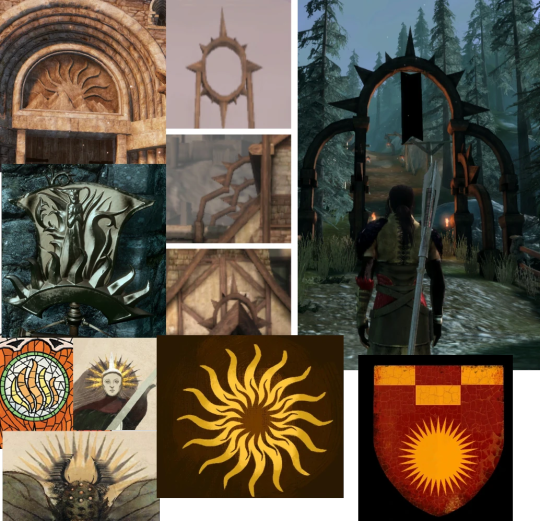
The most typical one that appears in DA series is the Sun or Sunburst with wavy rays, repeated so much along the games that we can identify it immediately. It’s the unequivocally symbol of the Chantry. We found it in many versions, and it represents the “dawn” with the idea of hope and “new beginnings”, but also the fire that “purified” Andraste in her pyre to let her ascend to the Maker’s side. In the posts of Andrastian Art [Andrastian Design: Stained Glasses], we also find that “balls of fire” [which can be interpreted as a Sun in another way] are shown to represent the Maker or the Faith in Him.
Andraste’s single spiked helm seems to be inspired in a single sun ray, at least this is what an illustration in the Chant of Light [book of World Of Thedas] seems to suggest.
In general, most of the representations of the Chantry Sun have 16 rays.
The same sun-like symbol appears in its Tevinter version when we see the Imperial Chantry; the only difference with the Orlesian one is that the Tevinter Sunburst has straight rays.
As a detail, in DAO, we had the typical representation of the wavy sunburst present in some strange devices of Tevinter origin, for example, the ones we found in [Brecilian ruins], while the main Church in Denerim, or in Haven, display spikes that, more than resembling a sun, look like thorns or even a thorny vine. This may be a consequence of an original plan in linking, design-wise, the chantry symbology with the thorny vines that represent the Blight or the Darkspawn [As we explained in the section “Non-mural symbol: Thorny vines” from Murals in DAI: Basics], or merely it was a limitation of the design of the game, as we know DAO suffers from.
We also know that tranquils should display this symbol on their foreheads, burnt with lyrium, but as we saw along DAO, none of them had it. Later we were informed that the devs had problems to add this mark on the npc, therefore, it was never shown until DA2. When it comes to this symbol, it is interesting to see that tranquils carry the metaphor of “a Sun burning their minds and emptying them”, which may or may not be related with Dwarves and their fear to the Sun and potential relatinship of Elgar'nar shoving a fire ball into their underground lands [More details of this concept in Deep Roads [DLC Trespasser]: Lower Walkways in particular with the codex Torn Notebook in the Deep Roads,].
[Strong] Elvhenan Culture: Sun symbol among the Evanuris
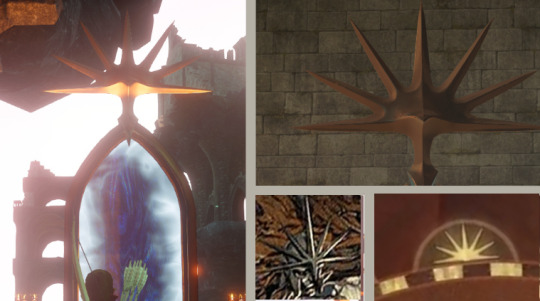
Strangely close to the Chantry Sunburst symbol, we find the “half” sun symbol [tagged along the blog as Sun-head creature] in what we suspect was one of the ancient primordial dragon symbols that some Evanuris took over when they claimed Divinity [for more context, read Attempt to rebuild Ancient Elvhenan History]. It’s hard to say which Evanuris took control of this symbol, but we know there is a clearly sun-like symbol present in the Crossroads of the DLC [as a statue, check The Crossroads [DLC Trespasser]: Entrance] and in the Shattered Library [as an Eluvian, check Shattered Library; Entrance and Courtyard]. With the release of the Vinyl, we also discovered and reinforced the hypothesis that this symbol belongs to or was co-opted by an Evanuris [read Speculations about the Vinyl Art for details] thanks to the image of an elf wearing a hat with that shape.
A consistent detail of this image is that it’s a half-sun with exactly 7 rays.
[Weak] Elvhenan Culture: Asterisk Symbol and Elvhenan Doors
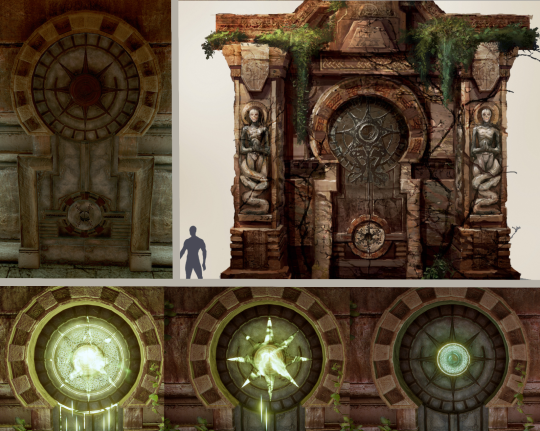
If we extend this imagery, and check other symbols that may look similar to a sun, we find the ancient Elvhenan Doors [Elven Ancient Shard-based door], which top displays a pointy sun of 8 rays that may or may not be related to the Asterisk symbols [also related to the Titan’s core, which I talked about in the post of Murals “The Death of a Titan”]. In the way the door gets illuminated when activated also makes us see a “circle” in it that can be loosely related to the “Golden Ring shape”. More details about this ring will be treated below.
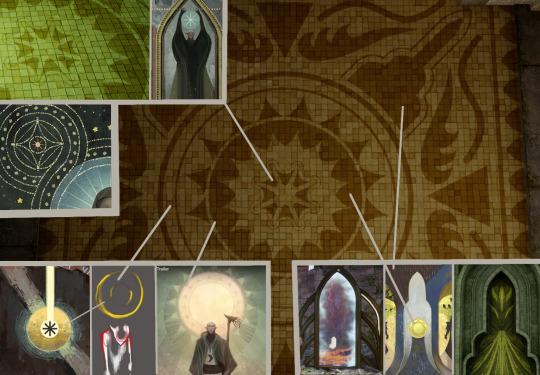
This strange sun on the ancient door also makes us think in the Asterisk Symbol [made of 8 points], which lays at the centre of the yellow mosaic, which may be related to the core of a Titan [asterisk of 8 points too]. The link is immediate when we see that this asterisk is outlined by a shape that looks like a star or a Sun, inside a big ball with triangular-shape ends. This same symbol appears in the last Trailer of DA4, behind Solas, when he is presented like an Hermit, mysterious, apostate mage. Around this “sun” we can make out several concentric lines that may refer to a “Golden Ring”.
The Asterik symbol also appears in murals such as “The Creation of the Veil” or “The Death of a Titan”, which allowed us to relate them with the core of a Titan and its immense power of "making real what you imagine"reinforcing the reality", but this symbol also appears in a corner of Solas’ tarot card.
The yellow mosaic also has some shapes at the four corners that may represent eluvians or something related to Mythal. In the mural of “the Temple of Mythal” from “The actions of the Inquisitor”, we see that Solas draw a particular star of 8 points inside a door frame that resembles this “eluvian outline”, but it’s also the shape of the doors of the Temple of Mythal which represents Mythal herself in her dragon shape. All these symbols seem to reinforce the idea we explored in “The Death of a Titan”: Mythal seems to be related to the core power of a Titan represented by an asterisk that evolves into a golden ring and into a sun.
As I repeated several times in Speculations about the Vinyl Art, at times, we find some hints where stars or balls of fires [also understood as suns] are related to Mythal and Elgar’nan, making us suspect that, maybe, Mythal and Elgar’nan share a nature similar to Falon’Din and Dirthamen’s: apparently, the same creature with two different aspects from them. If this were the case, associating Mythal with the Sun would make sense, and it would also explain why, if Elgar’nan was so central in the Elvhenan culture, there are so few representations and statues of him, while Mythal overwhelms it.
[Weak] Elvhenan Culture: Golden Ring
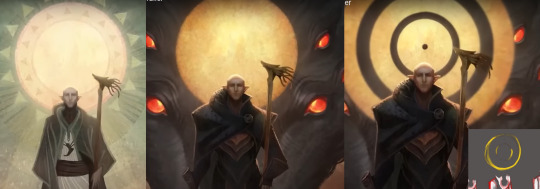
During the last trailer of DA4, we see Solas turns into the Black Dread Wolf as a sun in the background becomes a moon [single golden circle] and later, it separates itself into concentric rings, that may or may not be related to the “Golden Ring” so deeply entangled with Elvhenan culture. Thanks to this imagery, we may relate the Sun to the Golden Ring [specially if we consider that the mural presented in Nation Art: Elvhen displays the yellow ring in a position that may be considered “the sun”, but also the "authority/power above"]
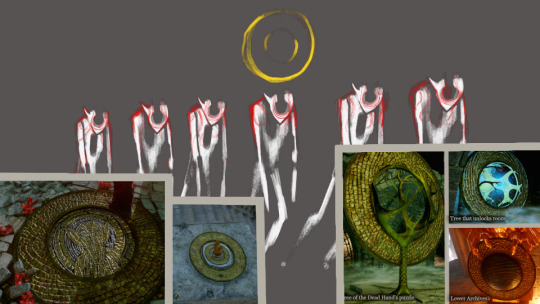

We need to remember that the Golden Ring’s presence is always associated with control, power, and occasionally to Mythal and Dirthamen. In the mural of the “zombie elves”, it’s above all of them, and due to this position, it could be interpreted like a “sun” or moon upon the controlled, zombified elves. But I’m not too convinced in this interpretation, since we already explored in posts such as: Nation Art: Elvhen, Exalted Plains: Ghilan’nain’s Grove and the Dead Hand, DLC: Jaws of Hakkon - Frostback Basin, Elvhen Tomb, Ancient Elven codices; Fen’Harel’s mountain ruins, The Crossroads [DLC Trespasser]: Elven Mountain Ruins; Vine-covered Tower, Murals in DAI: The Death of a Titan, and Speculations about the Vinyl Art that this ring was more related to control, power, or even forced change/shape in some cases. Due to its power or potential knowledge, it's also associated to Dirthamen Owl [which also could be Andruil's owl according some inconsistencies in the same Unreliable Dalish legends].
On the other hand, it’s never clear if this symbol may have morphed into a sun along the ages with the loss of memory that the Elves had throughout generations when they lost their immortality. However, I tend to consider that this Golden Ring may have changed into a Sun when it entered in contact with human groups, in the same way that I see the story of Fen'Harel gave enough context for humans to create the Maker myth based on him, potentially during the time of Halamshiral [for more details, read The Chantry and the Mythology of the Chant of Light]
This ring also appears in the last scene of DAI, when we defeat Corypheus, showing Mythal inside it, as bits of red lyrium sprout around it. This can be related to many speculations done in Speculations about the Vinyl Art, where we can conclude that another fragment/part of Mythal is still trapped in the Black City, corrupted, and contained by an immense power that may have been used before by the rest of the evanuris to control their own people.
The Golden Ring has also been seen enclosing Elven Tree Statues and Elven Orbs, implying its relationship with elvhenan power and/or Mythal’s [after all, we know that Mythal took the power from a Titan from which elvhen orbs were developed, and trees are also her symbol, according her vallaslin]. It's worth noting that the only working orb we saw in the game was Mythal’s, so far.
[Weak] Elvhenan Culture: Crappy Sun
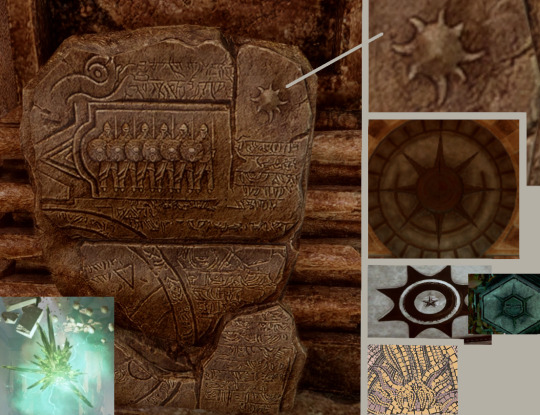
There is also a strange symbol that I called “crappy sun” in the ancient tablet we find at the entrance and deep into the tomb of Forbidden Oasis: Solasan Temple [along this blog I’ve tagged it as “Stone in Razikale-Ceremony-style”]. It’s hard to say if it represents a sun or a breach. It may be related to a sun similar to the one of the Elven Ancient Shard-based door that, later, Tevinter co-opted to turn into the several versions of pointy suns we see in Tevinter Pre-blight ruins, [let’s remember they were not Andrastian yet, and still they had this symbology in their buildings and elements because it may have been related to ancient dragons, or taken from another elvhen symbology during the time of the Dreamers since there are some proofs, such as the Tevinter Mosaic [Invasion], that may show that Tevinter had a better relationship with elves back then].
Maybe the original symbol was related to Elgar’nan, as we see in his mosaic, where he shoves down the sun into the earth, and its rays are wavy and a bit “crappy”. If this relationship is correct, maybe what Elgar'nan shoved into the Earth to destroy the dwarves/Titans was not a sun but a breach? Again, a very unlikely hypothesis.
This “crappy sun” also has 8 rays.
[Strong] Elvhenan Culture: Elgar’nan and Sylaise
Elgar’nan’s mosaic was interpreted in the post Evanuris, and basically shows an elf shoving down a Sun of wavy rays into the Earth. It’s easy for us to relate this image to the unreliable Dalish legend of Elgar’nan [read Elgar'nan: God of Vengeance]. Elgar’nan is presented here as the son of the Sun itself, who tried to burn all life on the Land out of Jealousy, so Elgar’nan vowed vengeance against his Father’s cruelty, and his rage won against the fire of the Sun. Then, “Elgar'nan threw the sun down from the sky and buried him in a deep abyss created by the land's sorrow.”
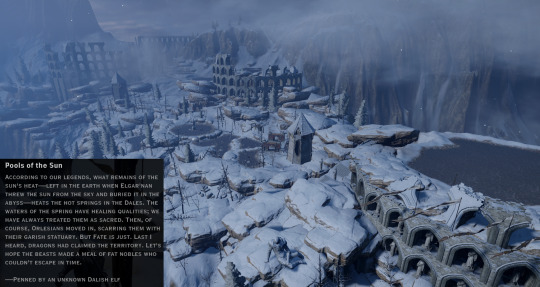
This story can be followed later in the post Emprise du Lion: Pools of the Sun, where we find another unreliable Dalish legend claiming that this place has spring waters because it was here where Elgar’nan shoved the sun into the Earth. I also made a link to Sylaise considering the Elvhenan arenas we can see in this region, the presence of Sylaise’s Shrine, and her thirst for being always competing with someone. These details can make us suspect that this Sun could have been Sylaise [so deeply related to fire, the sun, and also as angry as Elgar’nan according the Song to Sylaise].
It’s very worth noting that these two legends, said by different clans, claim that Elgar’nan pushed the Sun into the Abyss. Another detail we have to assume is that "Abyss", "Beyond the Deep Roads" and "The Void" seem to be one thing related to the places where the Titan sleep [or even inside the Titan themselves] instead of a strange dimensional pocket we never saw before. This links the Elvhenan with the Dwarven in what we speculated in Murals in DAI: The Death of a Titan.
With this relationship, we see again the Sun as a weapon of destruction and control.
[Weak] Elvhenan Culture: Murals

Murals present a red sphere with rays that may imply a Sun .
In the mural “The Creation of the Veil” [1], we find a red sphere inside a black one, making us suspect it’s the big evil released by the Evanuris that Solas isolated with the creation of the Veil. Around it, there are seven “bubbles” with similar “rays” in grey and golden colours that may imply “gates” that would allow us the access to the central “sun” or red sphere.
In the mural “The Death of a Titan” [2] we talked extensively about the asterisk symbol, its representation of a Titan’s heart and all that power associated with it, as well as with Golden Rings. The codex in here speaks of a red sphere that contains fury, and maybe all of this can be related to a sun, or better said, the other way around: a Sun as a sphere of fire, related to fury, and buried below underground to contain its destruction. This also brings us some similarities with the unreliable Dalish legends about Elgar'nan.
In the mural “Red Lyrium Idol” [3] we also commented how the image looks as if Solas were walking on a sphere of fire. It may be related to the red lyrium idol too. Here, we keep linking this idea of a “sphere of fire” as a potential Sun.
In the murals of “The actions of the Inquisitor” [4], we see several times that the red sphere associated with the big evil isolated behind the thick, impenetrable barrier of the Black City seems to be positioned in places that may allow a soft interpretation as a “sun”in the sky.
These symbols seem to gather more importance as we analysed the Vinyl Art, where we find the concept of the Eclipse [as an ominous symbol of Fen’Harel that covers and hides the Sun] and a lot of iconography of stars, which can be interpreted as “suns”.
[Weak] Tevinter Culture: Green Star

Pre-Blight Tevinter art has a “star” symbol that may be interpreted as a sun, specially if we consider that the inside of this green star displays the symbol of the elvhenan Golden Ring in red colour. However, it seems more likely to be a symbol representing the power that one can extract from the Breaches. The green colour helps in this interpretation and puts it a bit farther away from a sun interpretation than other symbols. However, it keeps linking the Golden Ring with the power of creating a Breach.
[Confusing] Tevinter Culture: different decorative elements
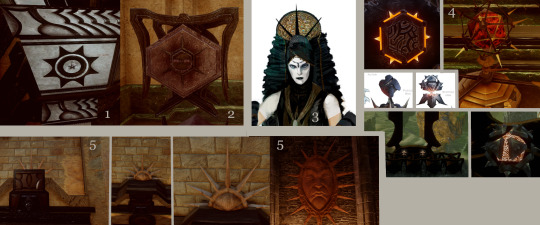
The rest of the symbols in Tevinter objects may have some relationship with the Sun. For example, we find doors, boxes, and columns decorated with an 8-pointed star [1] but we also find another one with 6 points in something that looks like a box [2]. The shape of an “hexagonal” sun of 8-pointy rays can be found as well in objects like the “scrying orb” [4].
Among the outfits, we find a 3-ray comb used by Tevinter women [3], which may be related to the sun-based symbol of an Old God [and potentially related to the corresponding Evanuris associated with it]. This symbol is a lot closer to the "Sun-head creature" we found among Elvhenan objects.
As a curious one, I will always point out the strange, hidden Sun figure that belongs to the Free Marches decoration that can be found at the entrance of the Inner Sanctum in Western Approach: The Still Ruins, Viridis Walk and Inner Sanctum.
I think it’s clear and safe to say that most of the sun-based symbols present in Tevinter culture [and previous to their conversion to Andrastian religion] may have been originated from the contact with the Elvhenan [during the Dreamer time where we can see less repulsion to Elvhen according the Tevinter Mosaics] or [most likely] with the dragons that may have been related to the Elvhenan, as I made the connection in the comic post The Missing.
[Weak] Dwarven Culture: Fairel and Dwarven art
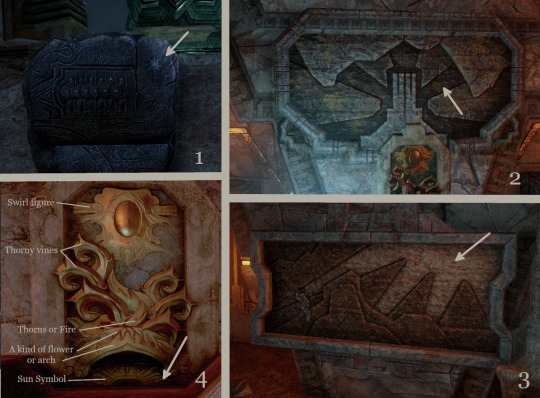
The Dwarves, at least the ones in the Fairel’s ruins, may have some link with the Sun as well. In these ruins we find the same exact stone tablet we find in the Ancient Elvhenan tombs [1], which displays the “crappy sun” I commented above. Once again, it could be a sun but also a breach, so there is no much sense to keep focusing on it.
Another symbol to relate the Sun to the Dwarves may or may not be an old “Dwarven stone-paintings” we saw since DAO, which basically shows a dwarf working the stone [3]. Based on symmetry, we could assume that the triangles on the background are stalagmites, but if we stretch-out this interpretation, they could even be seen as a sun with its rays. It’s very unlikely, since it seems to be more a design resource to highlight the scene of the stone-painting, but for completion’s sake I think it’s worthy to keep it commented here.
However, this simple design allows us to interpret it in different ways: the spikes we see can be pieces of rock protruding from the ground and the Dwarf in it is mining them [as its original codex in DAO seems to imply], but also it could be understood as a quarter of a Sun peeking through the corner of the image as a Dwarf works tirelessly.
Later in DAI we are introduced to another piece of art of similar characteristics [2]. The building was never possible to be identified unequivocally, and in posts like “Architecture of Kirkwall : Gallows and Lowtown/Darktown” I related it to representations of Kirkwall or cities that may be similar to Kirkwall where the runecraft mastery of dwarves was used [and probably, it was a source of pride for these clans, who may have kept the achievement immortalised in a piece of art reproduced among the noble dwarven families]. This piece also shows a background very similar to the one in [3] that may be a representation of stalagmites or a sun, if it’s stretched-out enough.
Another strange symbol in the dwarven furniture is the one presented in some stone-seats: an elaborated metal image that shows thorny vines on or over a sun [4]. This symbol appears in many other parts of the game where there are dwarven rooms, but also in Arbor Wilds :Cradle of Sulevin where we can read the Vir Tanadhal, However, in this case, the symbol is not completely the same one than in the Hissing Wastes: Fairel tomb.
It’s hard to suspect if this is a mere reuse of assets, it has a lore-related meaning, or it’s just a reflection that the Dwarves and the Ancient Elvhen had a relationship quite ancient [as it shows the Elvhen tree and its dwarven, more geometrical style, that I’ve been pointing out since DAO in Orzammar]. We have to remember that the Ancient Elvhenan saw the dwarves as soulless creatures, workers of the “pillars of Earth” and worthless. However, I always claimed it was never clear if this was a reference to ancient Dwarves that were linked to the Titan deeply to the point that they became Sha-Brytol after the break of the link, or were related to more independent dwarves as the ones we see now, who have a sense of Stone, but can’t understand the Titan with the exception of some gifted ones [such as Valta].
Finally, the dwarves have an additional aspect related to the Sun in the very unreliable codex called Torn Notebook in the Deep Roads, Section 2. I wrote about this codex in a more integral way in Deep Roads [DLC Trespasser]: Lower Walkways. But basically an ex-Dalish elf [now a Qun converted] relates Elgar’nan’s fire [which another unreliable Dalish legend, Elgar'nan: God of Vengeance, claims he shoved the Sun into the Earth] to the fear to the Sun that Dwarves experience [Read the section Elgar’nan and Sylaise above]. This may have been a Dev’s choice to makes us aware that there exists a relationship between the Sun and the dwarves, even though there is no lore material that can make it clear enough.
[Strong] Ferelden Culture: The Sun Face and the geometrical Sun

In the Tryptich presented in Andrastian Design: Tapestry and Tryptich, we find three symbols on top of each part of the scene: the six-snakes that represent Tevinter, the golden city above all the image representing the Maker or the Chantry Religion, and over the section of Ferelden/Orlais chantry, a 8-pointed sun which rays look like triangles. Once again, the resemblance of this symbol with the elvhenan sun in the mural “Temple of Mythal” is remarkable [check the Temple of Mythal in “The actions of the Inquisitor”] or the sun shape in the elvhenan yellow mosaic or in the background of Solas in the Trailer of DA:D. This could come from different roots:
1- An Orlesian root, considering how much of the elvhenan influence it had during the time of the Halamshiral and the coexistence of humans and elves in the Dales for some years [to the point where inter-racial families were made, as it was hinted all over the Exalted Plains]. I spoeculated how the idea of the Maker may have been developed during this time in the post The Chantry and the Mythology of the Chant of Light
2- Another potential root is related to the Alamarri root, and therefore, linked to the Avvar: this sun may be a representation of the Lady of the Sky for the same reasons I will explain below in the Section Avvars and the Sun.
We can find similar icon in the book World of Thedas, where they show a unique Ferelden Tryptich [3], which top displays this symbol with a sun that even may have a shape of a Golden Ring within it. In either case, we know that this symbol later was part of the Ferelden Chantry, which sun is very pointy, as DAO showed it [see the first section in this post: Chantry Sunburst].
In DAI, we find in some small towns of Ferelden, a unique strange Sun with a crying face [1]. On it we see a bird and a squirrel. It’s hard to know exactly what this is, [check the post Nation Art: Ferelden], but maybe it can be understood as a representation of Andraste made by Ferelden culture mixed with some local animals and fables created as a mixture of cultures, similar to the tale that related Wyverns to Andraste [check the wyvern section in Dragon Age Iconic Patterns: The single spike].
There is also a fish drawn in the DLC of Hakkon on a fisherman shack [2], which displays a pattern that can be related to the “crappy sun” designs on its skin. Not sure what to make about it. The closest is that the Avvar represented this symbol as a way to reflect what they may have seen in the Isle of the Lady, where a big ancient breach have been there, open, since the time of Telana [read about this in “The Veil and the preservation of the Waking World” from the post Frostback Basin [DLC]: Miscellaneous ].
[Strong] Grey Wardens and the Sun

The typical symbol of the Grey Wardens involves a chalice that represents the Joining ritual. It always displays a Sun, and not any sun: it’s one with a strong resemblance to the Sunburst of the Chantry. Let’s remember that the Grey Wardens was and is an independent Order that doesn’t respond to the Chantry, and even more so: it was created before the existence of the Chantry, and before Andraste was born. So any quick explanation that this sun is present in this object due to some potential influence from the Chantry seem unlikely.
However, as I showed in Western Approach: The Still Ruins, Main Chamber and Hall of Silence, there are griffons with this same chalice that belonged to pre-Blight Tevinter, maybe remotely associated with Dumat in some ways [since they appear in a hall called “Hall of Silence”, and Dumat=Silence]. We know that the Joining, as a ritual of blood magic, came from the knowledge of Arlathan elves and Tevinter Mages during the desperate times of the First Blight when nothing seemed to stop the darkspawn and even slaying Dumat did not work the first time. Therefore, this Sun may have some relationship with the elvhenan, the Old Gods, or just the blood magic that allowed the creation of the Joining.
[Curious] Avvar and the Sun
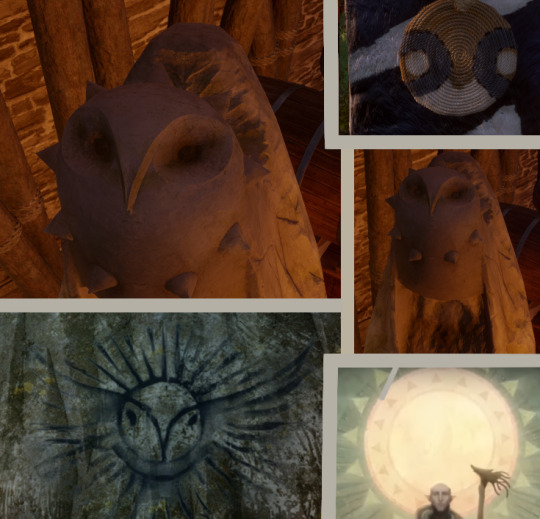
The Avvar have a symbol that I always found very Sun-like due to its design and cultural concept: The Lady of the Sky. It’s not only the concept; the lady of the sky can be any important object in the sky; moons or suns. Since Thedas has two moons, it seems more plausible to think of her as unique as the Sun itself.
In the painting that represents her (found on a wall in the Frostback Mountains) we see a design of an owl which shape looks like a Sun. Even her sculpture in Skyhold displays small spikes around her neck which give her a low-key “sun-like” design, specially if we relate this shape with the “sun” shape we saw in the Ancient Elvhenan Yellow Mosaic or with the star we saw in the “Temple of Mythal” mural [in “The actions of the Inquisitor”] or with the Sun that appears behind Solas in the trailer.
Curiously, her banner displays her eyes in a shape that looks similar to the Golden Ring shape, but in black colour. That the Avvar have an art that may have resemblance with Elvhenan's is not strange for me if we remember that Tyrdda Bright-Axe Path’s story narrates that her lover was an elf that, as it is hinted, may have been the Lady of the Sky herself. This means that the Avvar always were a culture under the influence of the Elvhenan and the Dwarves [due to the marriages they arranged with the children of the Stone].
[Weak] Flemeth
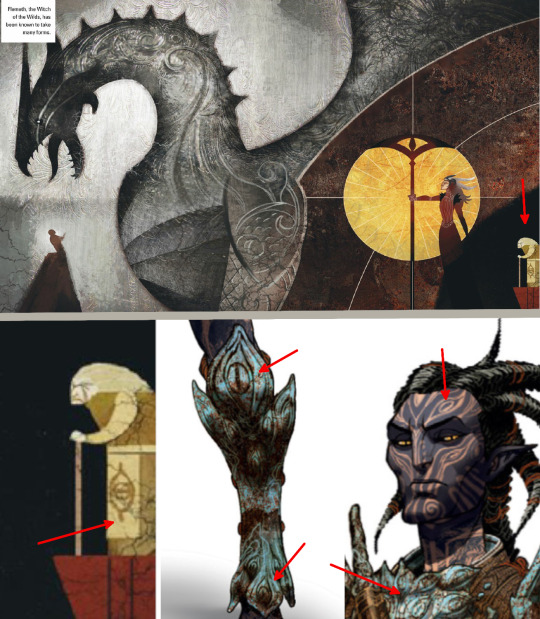
Flemeth also had a unique concept art that shows all of her nature in one drawing: her dragon shape, Mythal, as the central part of it over a human figure that may be a petitioner; a bit aside and as if she were in a inner ring of a brown sphere, The Witch of the Wild: Flemeth, with a very particular staff inside a yellow circle that may be interpreted as a Sun. And very hidden in the corner, in the core of this sphere, now black, we see her as an "old, old woman" with a big eye drawn on her apron, at the edge of a cliff [potentially representing the fragment of Mythal that lives inside her]. This kind of eye is very similar to the ones that we see in the concept art armours of Mythal’s temple guardians. I assume it has to do with her omnipresence due to the manipulation of dreams [we know that she presented herself in dreams to an elf and marked him with the Vallaslin of Mythal after awakening, check the video]
Mythal also has bland hints related to Elgar’nan symbology, which is related to the sun, fire, and balls of fire with anger [check all this in the posts Speculations about the Vinyl Art and “The Death of a Titan”]. Flemeth ends up being related to all this since she carries a fragment of Mythal in her.
[Strong] Qunari, Par Vollen, and the Solium Constellation
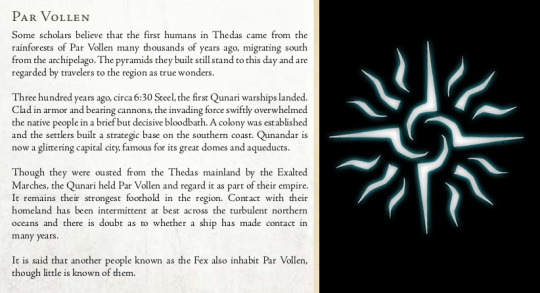
The Qunari have little link with the Sun, but not the land they conquered. In the book World of Thedas we are informed about the existence of the Fex, a race we never saw nor had much information beyond the fact that they exist. May they be related to the Sun or a Sun-base proto religion? We don't know.
In the Codex Constellation: Solium, we learn that this constellation [which looks like a Sun/Star, image above, pretty similar to the Chantry Sunburst I may add] may have been a representation of the Sun or the Moon [or both] for the Neomerian [Ancient Tevinters], however, it could also represent Elgar’nan, since unreliable Dalish legends claim him to be the “eldest of the Sun”.
Another Codex, called The Pyramids of Par Vollen, tells us that the Jungles of this continent have ancient ruins that doesn’t seem to be tombs but places of scientific purposes. The shape of these ruins fits perfectly with the constellation of Solium, making them, in some way or another, related to the Sun. These pyramids are a great mystery in the DA lore, especially for their total lack of information beyond this codex. We know their walls show images of “intricate sea creatures, shipwrights, musicians, archers, and kings. Odd figures are depicted, tall, horned, always in a position of authority and respect.” It seems that there was no resistance when the Qunari came to conquer this place, so we can suspect that this previous civilization embraced the Qun without much resistance, in part, because the Qunari have horns, and that caused respect and authority. Or the civilisation had been gone long ago when they came. Or it was a civilisation that was developed by or under the authority of the Kossith, the ancient Qunari who had no Qun.
The brief description of these ruins also makes me link it, potentially, with the underground ruins we find in The Horror of Hormak .
[Confusing] DAO design

This section tries to relate the Sun shape with designs that may make the connection a bit stretched or not truly reasonable, therefore, DAO leads this part, lol.
We find that many places along the game, specially the ones related to puzzles [Honnleath and Enchanter Wilhelm’s basement] or to Tevinter experiments [Ruins of Brecilian Forest] display a platform on the ground with a symbol similar to the Sunburst of the Chantry. I’m not sure why they are there, specially in the Brecilian Forest, since we know this was a fortress probably developed by Tevinter [ which potentially may have co-opted, as usual, an ancient Elvhenan building and claimed it as its own] just to be taken by Dalish and humans later. This Fortress is a mess in terms of design and statues that it displays, so it’s hard, if not impossible, to truly take it seriously. To me it all feels more like a reuse of graphical resources, but just for the sake of completion, I add the present section.
More of these sun-like platforms can be found in the Tower of the Circle of Magi [which could potentially make sense since the tower was made by Avvar and Dwarves, and it may be a representation of the Lady of the Sky, as we saw in the Avvar section of this post] but also in the Temple of Andraste or in Denerim at the Fort Drakon which makes less sense [unless it is taken as a symbol from the Chantry itself]. Again, these inconsistencies make me suspect the reuse of assets in a game that could not afford to have 5 different platforms designs.
[Confusing] Free Marches Rural Areas


Another place where I found a sun-like symbol was in a very disturbing image of the book World of Thedas associated with a cautionary tale told to Free Marches kids. In it, we see that people/children are punished if they go outside a bubble of darkness with small “sun-like” symbols floating around. Each of these kids have a symbol on their belly or head. Curiously, one of these symbols is a small spiral that I’ve brought the attention upon long ago in the post Hinterlands: Statues, paintings, and structures found in the open where we found the alamarri statue I called Eroded dragon skull which has a “G symbol” on its back, which, at the same time, seems similar to the one present in a reiterative way all over the elvhen artefacts and in some dwarven rug designs.
I don't know how to interpret this image, mostly like the big black bubble that contains these klids seems to protect or shield them from the dangers outside. The kids that "behave badly" are dropped outside of it and are consumed by the dragon fire/jaws of the dangers outside. So in a very stretched way, we can interpret this image that the bubble filled with Suns protects people, or at least, it's the right path to follow not to be eaten by those monsters outside.
Conclusions
To put an end to this post, I would like to bring a short conclusion that we may have reached together along it. The Sun in Thedas is an ancient symbol that mostly every culture took to exploit and use in their own representation of gods/power.
This fact alone is not strange, since in anthropology we can see that severals cultures on Earth have developed religious rites or created Gods out of the Sun itself. The Sun is a symbol related to warmth, light, food, life, and security, so it seems reasonable for DA Lore to take it as the main symbol of Thedas civilisations.
The Sun in current Thedas is immediately associated with the Chantry and Andraste: it is a symbol of hope, of dawn, that provide the idea of new beginnings; it’s also the idea of the Maker itself and the Faith people have in him. It's also the fire that purifies in order to grant ascension [Andraste's case].
When it comes to Elvhenan, the Sun is immediately related to Elgar’nan, who was considered, according to the underaliable Dalish legends, the son of the Sun itself, who in order to save the Land shoved the sun into the ground, potentially causing a great damage to Dwarves and Titans.
There is also a symbol of a half-sun in an Eluvian, a statue, and in a hat worn by an elf, that may suggest that an original god, represented by the sun [potentially an ancient Dragon] was worshipped by the Evanuris. Lately, that symbol may have been co-opted by one of the Evanuris when they took divinity and the identity of the ancient gods they worshiped.
Elvhenan also seem to take the symbol of the asterisk as an oversimplification of the Sun, which across the murals, is also related to the heart of Titans, to power, and to the Golden Ring, which is also associated with control. So, for Elvhenan, we may suggest that the Sun represents immense power, if not, Divinity itself, that may end up being related to the core of Titans. The asterisk is also associated to the orb, a big power object.
Since Elvhenan were the first civilisation we know that started in Thedas [besides the Titans and their children], their symbols of power [asterisk, orb, golden ring] may have evolved along time to reach human groups which developed, later, all the sun symbols that ended up in the Chantry’s.
Thanks to Tevinter, we also can suspect that the Sun may have been a representation of an Old God, since they have a lot of sun-related images in their decoration and objects that belong to ancient times in which they were not Andrastian yet [in fact, so ancient times that Andraste herself was not born yet]. This may mean that the Sun symbol cloud have been taken from the Elvhenan or from the Ancient Dragons. Through Tevinter style, we also realise that the Elvhenan Golden Ring may have been used to create Breaches, which again shows and seems consistent with the idea of relating it to power and control. The symbol of Sun in Tevinter culture may be related originally with Elvhenan or with Ancient Dragons that Tevinter used to worship.
Dwarves have little representation of the sun for obvious reasons, but due to the unreliable legend of Elgar’nan and the war with the Titans, we may establish a relationship in which the dwarves endured the Sun [or the Elvhenan power] at some point in their story.
Thanks to the Grey Warden we can relate a sun with the idea of ancient Blood magic or ancient Dragon blood knowledge, since the Joining is represented by a chalice with a Sun on it.
The Avvar also have a low-key representation of the Sun in their Lady of the Sky, which may be just consequence of their deep relationship with the Elvhenan culture.
Par Vollen may have more answers about the Sun and ancient times, but the lore of DA world is very scarce on this region of the map of Thedas, so we can only speculate.
#Analysis and speculation of Statues#golden ring#alamarri#avvar#Chantry#Dragons#Elvhenan#Flemeth#Grey Warden#High Speculation#Old Gods#Tevinter#Par Vollen#sunburst#Sun-head creature#evanuris#Elven Ancient Shard-based door#yellow mosaic#mythal#flemeth#Elven Owl statue#Stone in Razikale-Ceremony-style#Sylaise#Elgar'nan#Asterisk Symbol#Free Marches Sun#Dwarven stone-paintings#lady of the sky
73 notes
·
View notes
Note
How do u feel about them changing DA4 from Dreadwolf to veilguard?
i’m in favour!! veilguard is kind of silly but i think it’s cute. and if they’re being upfront in saying it’s because it’s more about you and your companions than about your enemies, i’m all for that
also, places where the veil is weak have always been, like, some of the coolest maps and ideas in dragon age. the brecilian forest? a disrupted circle tower? the blackmarsh? sundermount, or kirkwall in general? crestwood and the fallow mire? werewolves and walking corpses and talking trees and wandering wisps and demons barely kept at bay? that’s got to be the kind of place where a “veilguard” would be operating and the kind of thing they’d be dealing with, and i’m incredibly here for that
i like solas well enough but his plot isn’t really my thing, so less focus on it—although this is obviously still related—isn’t going to ruin my day
112 notes
·
View notes
Text
@avrorean
Regret is something I know well. Take care not to cling to it, to hold it so close that it poisons your soul. When the time comes for your regrets, remember me.
Upon waking from a millennia of slumber, the Dread Wolf hunts for an old friend.
When at last he found the strength to rise, Solas went not to the ruins of Arlathan in the north, but south to the Brecilian Forest. He chased a ghost, but he had felt her as he slept, and upon waking, her presence in this broken world was undeniable and as strong as before he'd rebelled against the gods. Mythal lived. And he would find her.
The forest had a deep memory, and it was untouched by the deafening nothing that permeated the rest of this world. His damned Veil felt so much thinner here than in its oppressive chokehold over the roads it took to get there. The forest did not repel him when he passed its borders, but its paths yawned before him in an ever evolving maze. Were he not so weak, he would shift into the Wolf and make the forest bend beneath his feet. But instead, he wandered into the dark canopy and followed the feeling of her presence.
He met a spirit inhabiting a grand oak who bid him welcome. It did not know where Mythal was, though it stated it had felt her presence some nine years ago in a Dalish camp not far south. He thanked the spirit and followed the winding paths to a long abandoned clearing. His lip curled at the few overgrown statues that remained, idols of Sylaise and Ghilan'nain and Andruil. He made his little camp near the crude carving of the Dread Wolf. It meant nothing to him but a point of focus. The Dalish clan had passed it in and out of their camp. He placed his wards and laid his head near its base, and used the totem to find them.
In dreams, he came upon the remnants of Lanaya's clan. They were no longer physically here, but they recoiled at the sight of him in their dreams. They prayed to the false gods and set ethereal hounds on him.
“They know you,” said Wisdom once he fled the hounds.
“They know nothing,” said Solas, and retreated deeper into their minds, burrowing past their consciousness into their memories.
A hedge witch, human, who felt more than looked like the Mythal he had known. But even this memory of her was cloaked in a spell that obscured her entirely, hiding her even from those who would wander the Fade. Shrewd.
“It is her,” said Solas hopefully.
“A shade of her,” Wisdom allowed.
So he looked to her companions for some clue to find Mythal. The smallest was in front, the apparent leader of the ragtag troupe. Young. Terribly young, even as mortals went in comparison to him. She had an earnest face, and though lines were drawn below her tired eyes, they still shone with the wonder of youth.
But now Solas recoiled. Her blood was poison, as was the taller half elf at her side. Corrupted by Blight. He had not been awake long, and had engaged few in conversations during his dogged beeline towards the feeling of Mythal. He had seen the Blight scars in Ferelden, but he hadn't seen it in a person since he'd held back the sky. The infinitesimal change in their eyes, the hue of their skin, the smell of a slow, creeping death within the blood.
He thought he heard an all too familiar laugh.
It shocked him awake in a cold sweat of fear. After all this time, Ghilan’nain’s reach remained indomitable. That fear chased all thought of returning to slumber. Could she hear him, even now, trapped for millennia? Could she still feel him?
He sought out the Grand Oak once more. It knew little of the goings on of mortals, but told him the tale of the spirit of the Forest and the Grey Wardens who had brokered a respectful peace between spirit and elf. Solas begged for anything else it might know so he could chase the memory in dreams. It had none.
He left the Forest for the nearest sign of what passed for civilization in Ferelden. It was a roadside inn, nothing special, and they called him knife ear but passed him a two day old bowl of 'stew.' He ignored it all, and spun a believable reason for them to discuss the Fifth Blight. They focused on their 'heroic' war stories, and Solas nodded along respectfully while his fist clenched into his robes beneath the table. At last, the conversation turned from the haunted Brecilian Forest to the tragedy at the Circle tower on Lake Calenhad. "What was her name?" he insisted at last, the veneer of the humble elf slipping slightly with his frustration.
"Who, the Hero of Ferelden?"
"Yes," he said, his jaw clenching.
"Dunno."
Another legend that subsumed an identity. "And her companions?"
"One of them was the bastard son of the arl of Redcliffe."
"The king, not the arl."
Redcliffe, then. It would do.
The journey from the western edge of the Forest to Redcliffe village was a long one. Signs of the Blight persisted along its path, as did the fights between mages and templars that scattered the Hinterlands. He watched them from the shadows in distaste. He felt the dispelling of magic the Templars relied on, and watched mages crumble. They were unorganized, angry, and more than a few turned to blood magic in desperation. Each skirmish was a messy affair that fizzled out as quickly as they began.
The thatched roofs and wooden domiciles around the docks of Redcliffe Village looked largely new. Save for the Chantry, there were few surviving stone buildings. Another effect of the Blight, he assumed. At least they had rebuilt. He found in its center an old storyteller, humored and ignored in her ravings by the village's inhabitants. He went to her first, and she spun a tale of the Fifth Blight that seemed more true than not, albeit embellished and flowery. "Alistair," she confirmed the name of the bastard son. Proclaiming that he could have been king.
He did not rent a room at the local inn. He instead sat on the far edge of the docks, allowing himself to fall into an uneasy sleep. From the Fade poured darkspawn and the screams of the villagers. In the thick of a desperate battle, the vestige of Mythal's face remained obscure. The bastard Alistair slashed with a sword and shield, effective despite his lackluster armor. A mabari war hound bayed as it released a hurlock from its maw, and a proud Qunari warrior cleaved with a greatsword. Magic hummed beyond them, and he followed its trail to the child he'd seen in the Forest. This must be the so-called 'Hero of Ferelden', then. A mage, which he approved of dispassionately. But still as poisoned as Alistair.
“They need not have chosen this battle,” said Wisdom.
“Why did they?” asked Solas, though he knew before Wisdom gently pushed.
“For the same reason you chose yours.”
“Futile, then,” he said, bitterness lacing his words.
“Not to the people who lived. Not to the people saved.”
The dream changed. No more where they in the muddy chaos of Redcliffe village but within the simple stone walls of the castle itself. A child’s shrill voice rang with laughter as a demon puppeting it.
Mythal’s echo was there, her face still obscured as if in a fog.
“A glamour?” Solas mused.
“A safeguard,” Wisdom corrected.
Fear seeped off every stone and in the faces of each paralyzed human. The demon’s grip was too strong. But the little mage stood firm, her hand outstretched. The memory pulled as Fade cast Fade, and the little human met the demon in its own domain.
“She is afraid,” said Fear.
“She persists,” said Valor.
“She is not who I seek,” said Solas.
“She may be,” said Wisdom, and the girl triumphed. She stood for a moment alone in the Fade, the expression on her face far from glorious as the ring of unseen spirits encircled her.
“She slips, poisoned, mourning, breaking. Harrowed,” said Compassion.
The girl looked up. She did not see them, but Solas saw her. She was so young.
Solas woke with the dawn, and caught a dwarven bookseller as he opened his shop along the lake’s edge. “Where is the Circle?” Solas asked.
“Of magi?” the dwarf scoffed. “Other side of the Lake, but no use going there now with the mages all over the countryside. Best steer clear.”
It was not so far a journey following the path around Lake Calenhad. He took the road at times, and others he trudged through the mud for a more direct route. The lake was, at least, peaceful, save for the old wooden wrecks still dotting its beaches. There were fewer open skirmishes between mages and templars along this route, but they’d instead been replaced with bandits stalking the edges of the road. Solas may have been much weaker than the past, but he had the advantage of underestimation. A lone elf in ragged clothes, wandering an unfamiliar road through the dead of night? The bandits did not expect even this neutered discharge of his magic. They posed little problem.
It was sunset by the time he reached the tower. The dock at Kinloch Hold was deserted. The windows of the small tavern were boarded shut. It was as good a spot as any to make camp. But before he rested, he stood on the shores and looked out at the imposing tower jutting from the lake. Jagged rocks flanked its spiral sides, blotting out the brilliant orange sunset. A long bridge had crumbled away, restricting access to boats. How anyone could look at this and see anything other than a prison he did not know.
The Veil felt like it had been ruptured and clumsily mended here. There were as many demons as there were gentler spirits congregating around the abandoned husk.
Solas forced the boarded door of the tavern open and laid out his bedroll. There were too many memories intertwined here to easily parse through. In one, Mythal’s masked echo fought through a horde of demons and blood mages with the bastard and Hero of Ferelden, cutting a path to the tower’s heart. He tried to focus on the witch, but the little Hero had paused in a doorway.
“She is…crying,” said Solas.
Wisdom said nothing.
As before, Fade pulled on Fade, and in one corner of his vision the little Hero slumped to the floor before a demon of sloth. In the other, she followed spirits through a maze of memory. The sloth demon was felled, and the party rose shakily to their feet.
Purpose found him then, and guided him to another memory. A restored Circle not yet marred by the demonic chokehold, where the young Hero stood before a stern Templar and her mentor alone, facing the punishment of another’s crime. Her face was pale and her robes looked too large for her.
An elder Grey Warden, the blight fully steeped in his blood, intervened.
“He brings poison,” said Vengeance.
“He brings deliverance,” said Hope.
“The two are not so dissimilar,” said Solas. Words were exchanged, but Solas drew on the Fade to wake.
Before he could, Wisdom took his hand, and together they followed the elder Warden and the little mage out to docks. The sun rose a delicate pink over the lake, the tower’s shadow receding the further the Warden and his charge went from the confines of the Circle.
The young Hero crouched before a blue wildflower with a look of pure wonderment on her face. Her small fingers glided over the fragile bloom, and where Solas expected her to pluck it from the ground, she simply leaned in close to smell it.
“Fresh, free, clear and uncluttered,” said Compassion.
The older Grey Warden said something, his voice lost in the swirl of the Fade’s recollection. But the young girl turned with excitement toward a robin on an adjoining tree.
“Unmarred and unfiltered, they sing to her and she listens,” said Compassion.
“Such things are fleeting,” said Solas.
“Yet no less worth enjoying,” said Wisdom.
“This memory is not wisdom,” said Solas. “It is frailty.”
“No,” said Wisdom, “it is curiosity.”
The girl laughed as the robin fluttered away and a fox stretched awake with the breaking of dawn.
“This is pointless,” Solas insisted, the grey of his regret choking the beauty that he refused to see. “Where do they go?”
“To her, the journey is just as important.”
“It is not to me.”
“Patience, Wolf,” pleads Wisdom. “Allow her this dream.”
The girl held a branch of fern in her hands, running her fingers along the seedlings as she tucked a fallen flower into her hair. She smiled.
“We must press on to Ostagar,” said the elder Warden, exasperated. Impatient.
Ostagar. “Is it far?” Solas asked in time with the girl who asked the elder the same.
He didn’t wait for Wisdom’s answer. Solas pulled its location from the elder Warden’s memory, and the dream dissipated around the girl as she cast one last look at the rising sun. “She needs this,” said Wisdom.
“I don’t.” And Pride returned to the waking world.
Ostagar was too great a journey to walk without wasting an inordinate amount of time. Solas watched caravans pass on the road around Lake Calenhad and stepped to the side of the road when at last a promising one drove toward him.
An elf driving a cart, haggard and bare-faced as Solas himself. The elf blanched at Solas’ request for a ride to Ostagar, but the elf agreed to take him as far as the Hinterlands.
“You don’t want to be going to Ostagar,” said the elf as Solas sat beside her on the cart. Her cargo was a meagre assortment of vegetables from a humble farm, well past the date of their freshness.
“Don’t I?” Solas said distractedly.
“Them woods are haunted, friend,” said the elf. “The Blight’s never left.”
“If that were true, I suspect we’d be long dead.”
“You Dalish or something?”
Solas scoffed. “No. Why do you ask?”
“You talk funny.”
“I’m just tired,” said Solas, and that appeased the elf.
They rode the better part of the day, the elf looking around at every rustle of branch. The shems didn’t like elven merchants, she explained. Or any elves in particular. “Better with two of us than alone,” she said.
“I suppose,” said Solas.
The elf was from Denerim, and her anxiety filled the silence Solas craved. She talked of the mages and templars, the Blight, and everything else that came to her mind as she tried to fill the nervous silence.
“The Blight ended in Denerim, did it not?” asked Solas.
The elf shuddered. “Terrible day,” she said. “I was in the alienage. Didn’t think I’d see another sunrise. Thank the Maker for the Wardens.”
Solas took the opportunity to look to the tree line to hide the roll of his eyes. “You saw them?”
“The Wardens?” the elf sighed wistfully. “I did. She was wonderful, even for a mage.”
“She?”
“The Hero of Ferelden. They didn’t have to come and help us, but they did.”
“Did she have companions with her? Another mage, perhaps?”
“Aye,” said the elf. “But - ”
“What was her name?” Solas insisted. If he could get the witch’s name, it might make it easier to break the masking spell she’d used.
“Amell,” said the elf. “I’ll never forget it. Her armor was dented and ill-fitting. There were just the three of them, the Wardens.”
“Not the Wardens - the witch.”
“Oh,” the elf frowned. “I don’t know. I didn’t much notice her, not with the Hero of - ”
Solas sighed. The rest of the journey passed with the elf’s romanticized tales of the Hero encircling darkspawn with the very force of nature that the alienage itself rarely saw.
When they finally paused for the night, Solas inscribed a rune ward in the elf’s cart, and slipped away while she slept. It would keep her safe, and that was payment enough in his mind.
He did not sleep that night, not when he knew that Wisdom’s chastisement waited on the other side of the Fade for him. He walked through the Hinterlands beneath the constellation of Silentir looming above him. He rested at sun up for a moment, looking out at last over the darkness at the edge of the Hinterlands. The haunted forest of the Korcari Wilds.
Solas felt the shift in the air the moment he passed through its borders. It was old, familiar magic. His heart stirred at last. It was the unmistakable imprint of Mythal. He was getting close.
At first, the scars of the decade old battle were few, but the closer he got to the ruins, the more debris littered the ground. By the time he reached the open field of battle, he had to step around rusted blades, broken shields, and the bones of the long dead. Ostagar loomed above him, and he picked his way up into its gutted halls. A great battle such as this would see many spirits, and even for him, it would take time to sort through the disparate memories.
He dreamt at Ostagar for three nights.
aOn the first night, he waded through the memory of battle to the night before. The elder Warden stood above the corpse of a warrior, his blade darkened with crimson. The young girl from the Circle, from Redcliffe, and from the Brecilian Forest stood with a goblet too large in her shaking hands. Poison swirled within it, and her eyes were wide as she realized that her only two options were death.
“She would rather have watched the sunrise,” said Wisdom.
“It would have ended the same,” said Solas.
On the second night, he saw the memories of the terrible struggle. On one flank he saw an old warrior in simple but well-cared for armor. His eyes were sunken, his black hair matted to his sweaty brow. The veteran commander looked at the carnage, looked at the terrified faces of his soldiers, and called a retreat, all while a great signal fire burned atop a tower behind him.
“He abandoned them to die,” said Despair.
“He left to save them,” said Compassion.
“He knew the battle was lost,” said Wisdom. “He would not lose more.”
“And yet he did, in the end,” said Solas.
“You would have done it better, Wolf?” Wisdom pressed.
“I would not have done it at all,” said Solas.
“As you say,” said Wisdom, catching his lie, and they watched the elder Warden struck down in a sea of black and red. A blighted ogre tore Ferelden’s king to pieces. The screams of the dying and the corrupted rang out from the splintered cement.
On the third night, he followed the two young Wardens into the tower. Purpose ran with them, guiding them up the spire. Hope kindled the flame as they lit the brazier. Despair encircled them as the charge never came.
And then, at last, Solas saw her. Not the hexed shadow he'd been following, but her. The great beast plucked the unconscious Wardens from the top of a flaming tower. She seemed to see him as a grin split her draconic face, and his heart leapt. She had been here. “She lives.”
Solas forced himself awake and to his feet. He followed the echoes of memory deep into the Korcari Wilds. She felt close enough to touch, and no amount of wisdom could slow his run.
What hope he’d felt died in his chest when he reached the dilapidated hut at the Wilds’ heart. It had long been abandoned. The earth near its simple door had been scorched from battle.
“They killed her,” he choked.
“She does not die so easily.” It was not the voice of Wisdom that answered. He had not realized he’d fallen asleep.
“Show me,” he pled.
But the scene did not change. Not immediately. Words of memory swirled around him, and in them, Solas recognized her voice.
So much about you is uncertain, and yet I believe.
Figures danced as shadows shimmered into the Fade. They were faceless and incorporeal. All but one. She stood not a foot in front of him, alone as she had been at the Circle, in the Fade, and in the forest. The little mage stared at him with wide eyes, fear hitching her every breath and resolve steeling her every heartbeat. The others didn’t matter. Not the bastard, not even the witch. Their shades fell away until it was only the Hero, Solas, and the unmistakable presence of Mythal.
“Who is she?” he asked at last.
“The one who stopped a Blight.” It was not Wisdom who spoke to him. He was no more alone than this Hero had been when she stood before this hut.
“She survived?”
“She did. As did I.”
The Hero continued to stare at him, and he did not turn from her to face Mythal. Ghilan’nain’s poison was fresh in her veins - but then the scene shifted. The same hut, the same pair of them facing each other. But the Hero was older, her armor finer, the corruption more pronounced. Yet her eyes were no less afraid, and her heart was no less resolute.
“Who is she?” he asked again.
“Hope, compassion, destiny. Love. Or just a girl.”
The dream began to collapse around him until, for a moment, there was nothing but air between the little lost mage and the Dread Wolf.
The presence behind him began to fade. “Where are you?” he asked it.
“Oh, you know me,” chuckled his very old friend, cryptic as ever. “Around.”
#i found this mythal quote from da2 and i was like holy shit thats topical#this is LONGGGGG#i call this: Solas watches a let's play of Dragon Age Origins#avrorean#drabbles
8 notes
·
View notes
Text
my warden indaryn surana
he is VERY excited about ancient ruins and temples like he will go to every forbidden room and try to open every philactery in his way he has this urge to know EVERYTHING
lucky in the brecilian forest he just learned arcane warriors' magic and didn't release another revenant


#dragon age oc#dragon age#warden surana#my oc#art#sketch#dao#dragon age origins#dragon age fanart#grey warden#my art#my ocs#indaryn surana
110 notes
·
View notes
Text






Finally, I've made some more of those picrews of my Rooks using the "Little Guy Maker" (Link)! Unlike my two Adaars, my lovely Qunari actually does have her proper skintone!
Here are the links to the posts about my Wardens and Inquisitors!
While they're all still very much so in development, I feel like I have a solid enough idea of them all to give them at least a paragraph's worth of description!
First up is Sascha Ingellvar! Every round of custom PCs I have has to have at least one neurotic redhead, and Sascha is the Rook that bears that torch! Abandoned in the depths of the Grand Necropolis as a child, Sascha has never truly known what it's like to be a part of a family. The members of the Mourn Watch are not only professionals, but Circle mages, and don't have the time to do things like "nurture" and "love" a baby. Awkward, suffering from frequent episodes of muteness, and gangly, all he wants in life is to be seen as a person capable of being loved.
Next to Sascha is Omri de Riva! The son of a casteless father and a noble mother, Omri has been despised since birth for causing his mother to be stripped of her caste and thrown onto the Surface. Eventually settling in Kirkwall, Omri's mother jumped at the chance to sell her son to the Crows as soon as possible. Shipped off to the de Riva house at thirteen, Omri quickly became Viago's pet project, the then-twenty year old assassin using Omri to prove how good he was at molding assassins. Omri lived, but lost his sense of self and taste as a result of all the abuse and poisons. He has a protective, paternal side, and did his best to keep a little girl, Sheraliase Lavellan, safe from the worst of Viago's "training," doing all he could to take the fledgling under his wing and keep her by his side until they were separated to keep them from getting any ideas of running away together. Will he share any of this with his friends? His lover, Neve? Ha! Of course not!
Below Sascha is Tamaris Aldwir! Often called "Tammie," Tamaris is a deeply compassionate and soft-spoken woman, but she's not afraid to put herself on the line for those she cares about. The daughter of two hunters in Zathrian's Clan, Tamaris was fascinated by the magic of the ancient elves. At the age of sixteen, she got her vallaslin—marking her with the design of Mythal for her maternal and self-sacrificial nature. Despite being poised to become the First to Zathrian, she gave up her position to help get Lanaya the spot, which she hoped would get the girl to be more accepted by the Clan. When Zathrian was revealed to be lying about the source of his immortality, Tamaris was devastated, but didn't let it stop her. She dedicated the next six years to exploring and cataloguing the Brecilian Ruins and others around it. When a group of Veil Jumpers met up with the Clan, she eagerly went with them, taking copies of her work. She proved to be an invaluable source of knowledge due to her Southern upbringing, which differed quite a bit from those native to the Arlathan forest.
Next to Tamaris is Tamassran Laidir! Often called "Masra" by her non-Qunari friends, Tamassran is a loyal adherent to the Qun. At the age of 24, she was sent to Rivain in 9:35 Dragon along with a ben-hassrath partner and several other members of the Ariqun, eventually infiltrating the Lords of Fortune in 9:42 in order to keep an even closer eye on Isabela, the thief of the Tome of Koslun. While initially despising the woman, she soon grew to care deeply for the Lords of Fortune, even if she's still loyal to the Qun. She helps keep them away from stealing Qunari artifacts, not for any moral reasons, but because she really doesn't want to fight her new friends when the Qunari wage a war against them. Masra is seen as the "mother" of the Lords of Fortune, and was sent to help stop Solas due to her skills navigating high-stress conflict with grace and an incredibly strong will.
Below Tamaris is Ishal Mercar! When she was three years old, her parents, two nobles from Orzammar, died of a mysterious illness Ishal swears was a poisoning. Due to the close ties between her family and the Mercars, Lord Mercar made his way to Orzammar to pick up the little girl and bring her back to Tevinter, changing her name from the dwarven "Eshaal" to the Tevinter version of the name, "Ishal." Her adopted parents and older brother were all mages, making her the odd one out in more ways than one. She spent her childhood training with one of the Mercar's highest-ranking guards, and came to the conclusion that he was better with a blade than any noble-born she'd ever met, shattering her ideas of the value of blood-determined caste and class. As a result, she fell in with the Shadow Dragons, both going on missions—unbeknownst to her family, of course—and supplying them with her family's surplus weapons.
Next to Ishal is Vincent Thorne! His father, Gabriel, attempted to run off to join the Dalish, but after getting a member of Clan Lavellan pregnant, he ran back to Halamshiral rather than face the idea of being a father. It didn't take long, however, for him to fall in love with Violette, an elven servant and model to a human painter in his native city of Halamshiral. Vincent grew up in the artist's studio with his four younger sisters until a chevalier attempted to rape his then-thirteen year old sister, Georgette, when Vincent was 17. He stabbed the man to death with a wood-carving gouge in the middle of the artisan's market. Before the Orlesian authorities or a mob could string him up, a witness, Gordon Blackwall—the real Blackwall—invoked the Right of Conscription, astounded at Vincent's bravery despite knowing only death awaited him for his actions. Vincent, nicknamed "Vinny" by the Wardens, is extremely dedicated to his cause, extremely dedicated to his loved ones, and extremely annoyed at the way people keep calling the elven gods "his people's" gods.
#original content#sascha ingellvar#omri de riva#tamaris aldwir#tamassran laidir#ishal mercar#vincent thorne#dragon age#dragon age the veilguard#AAAAAAAAAAAA OFFICIAL ROOK POST#feel free to ask me anything about these little guys#I love them so much even if the game itself and the way it seems to want you to play rook makes me want to rip my hair out
4 notes
·
View notes